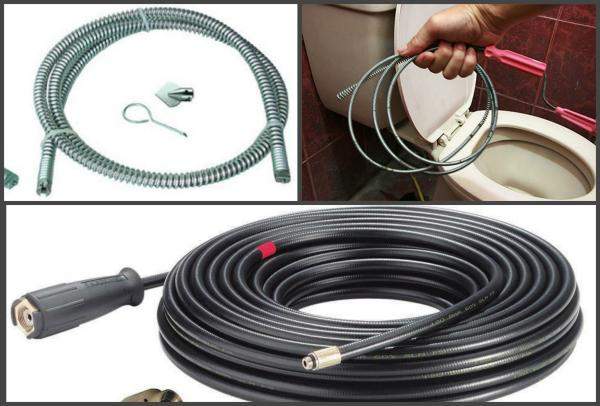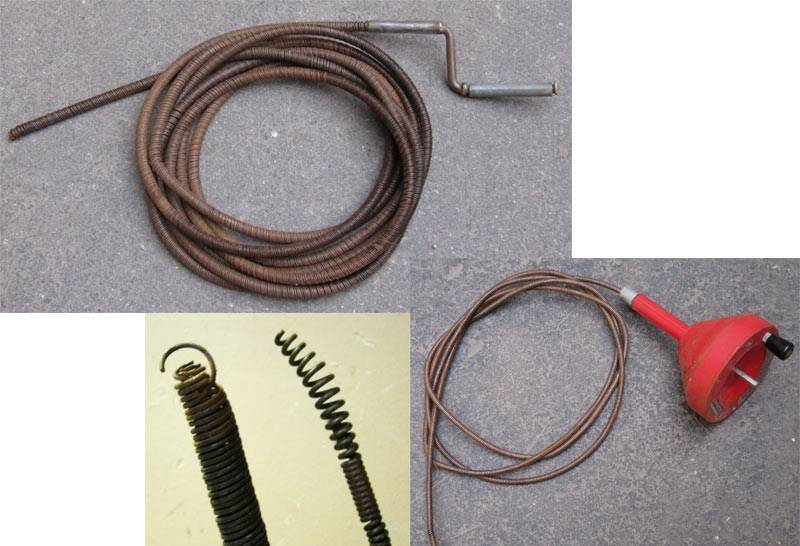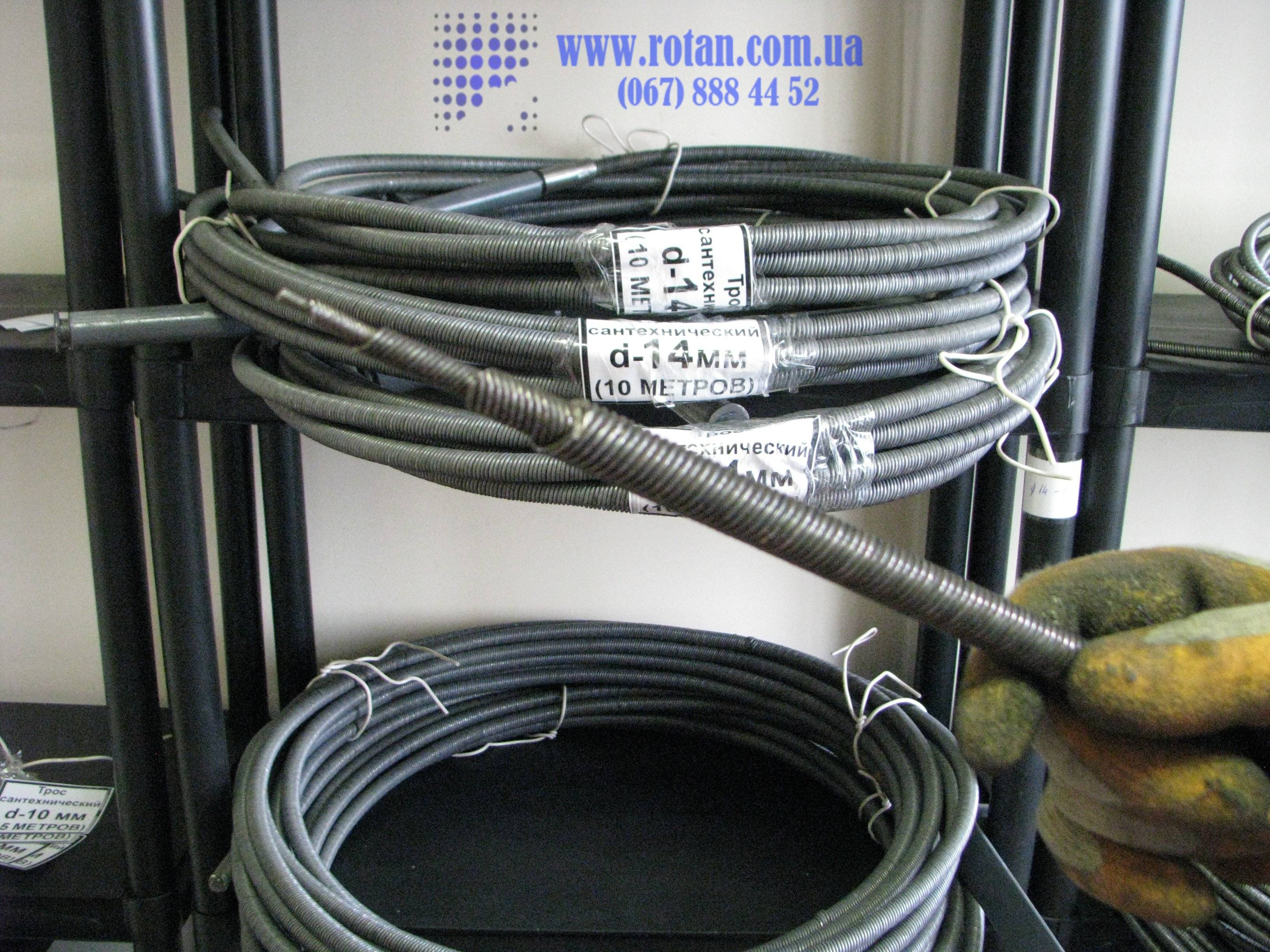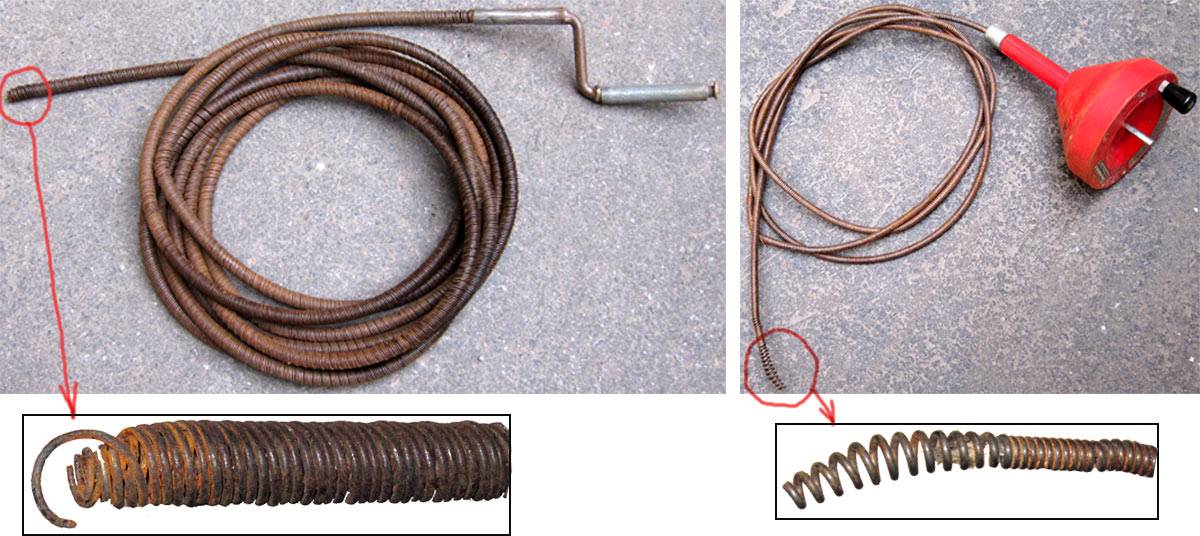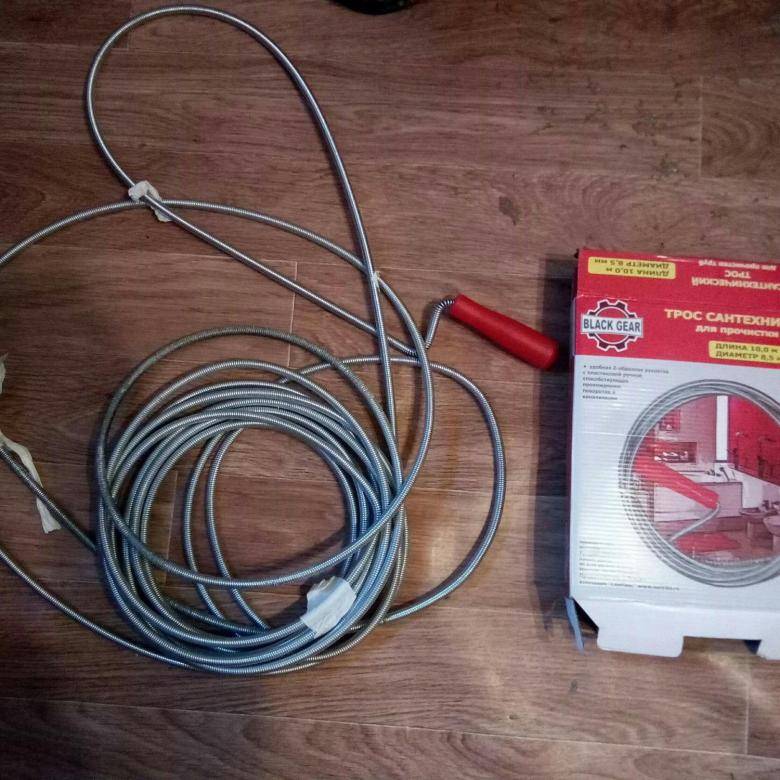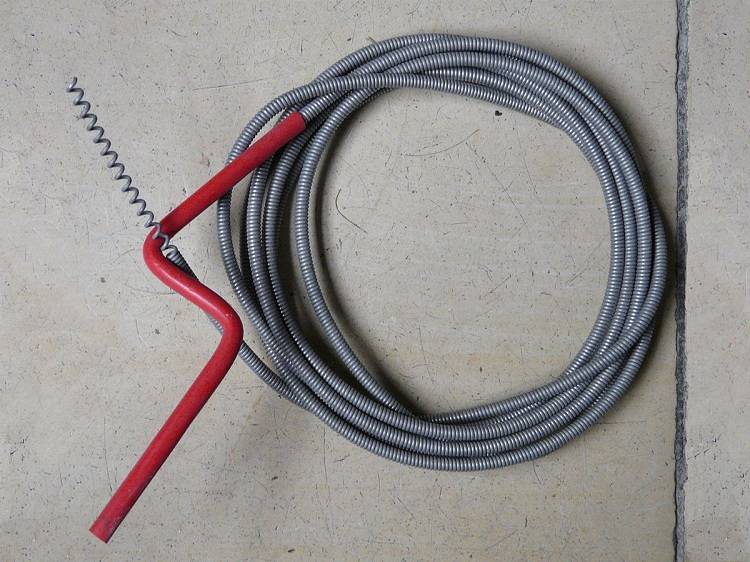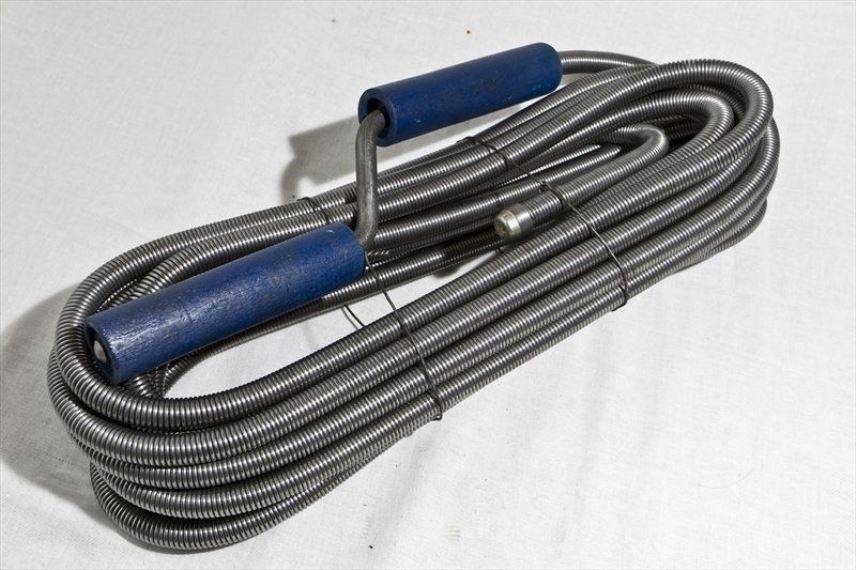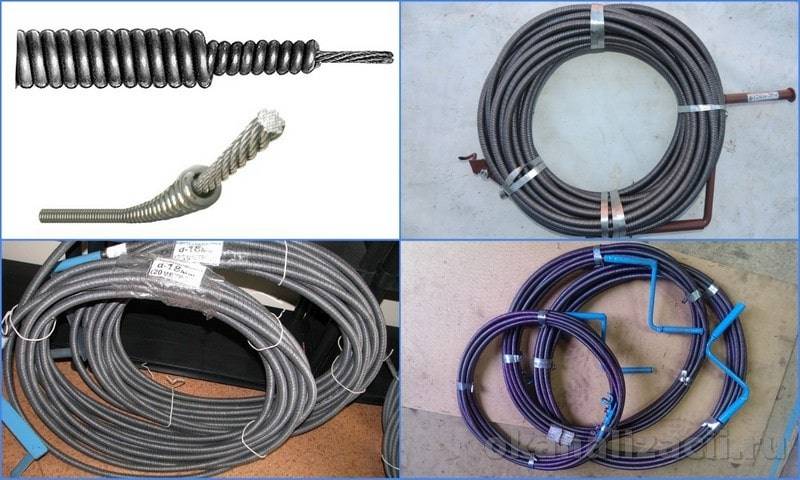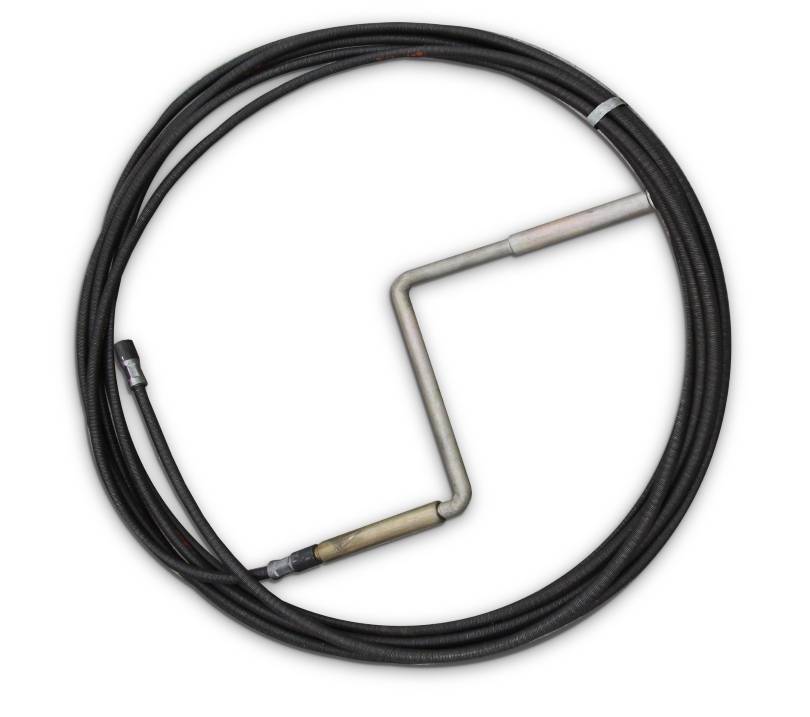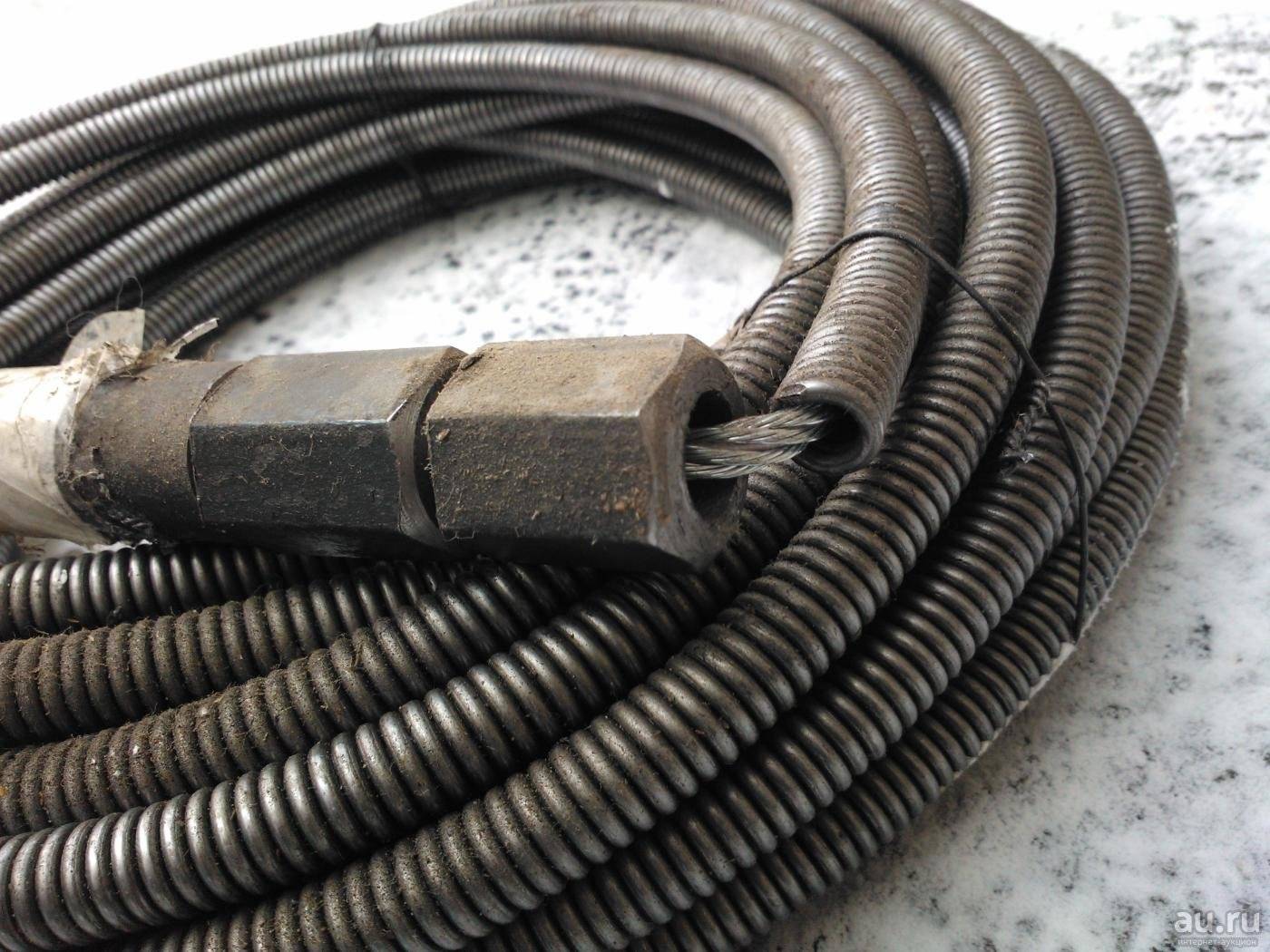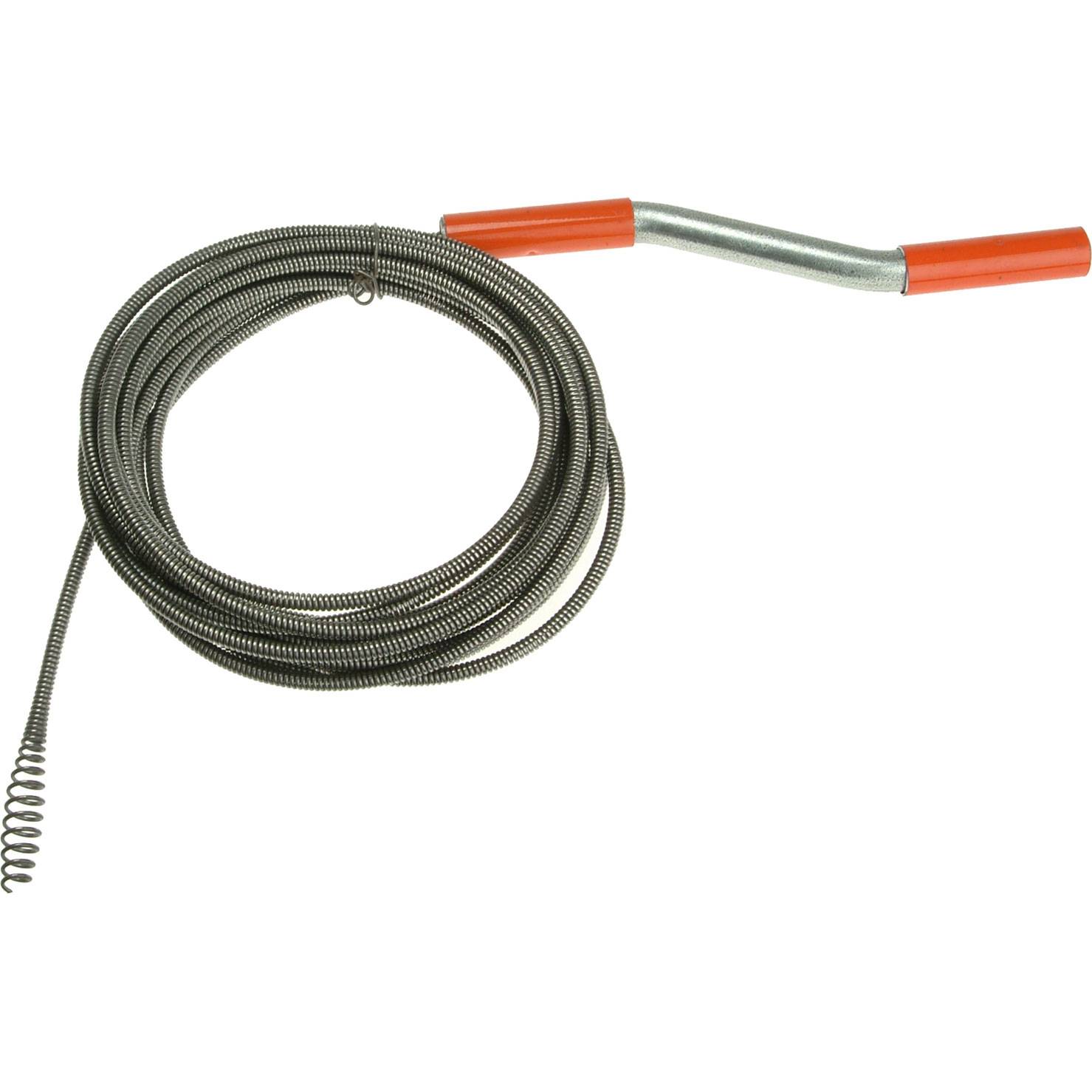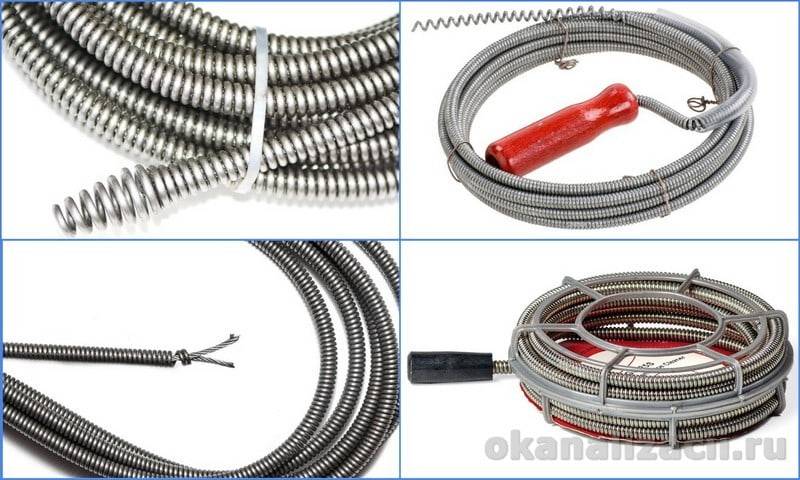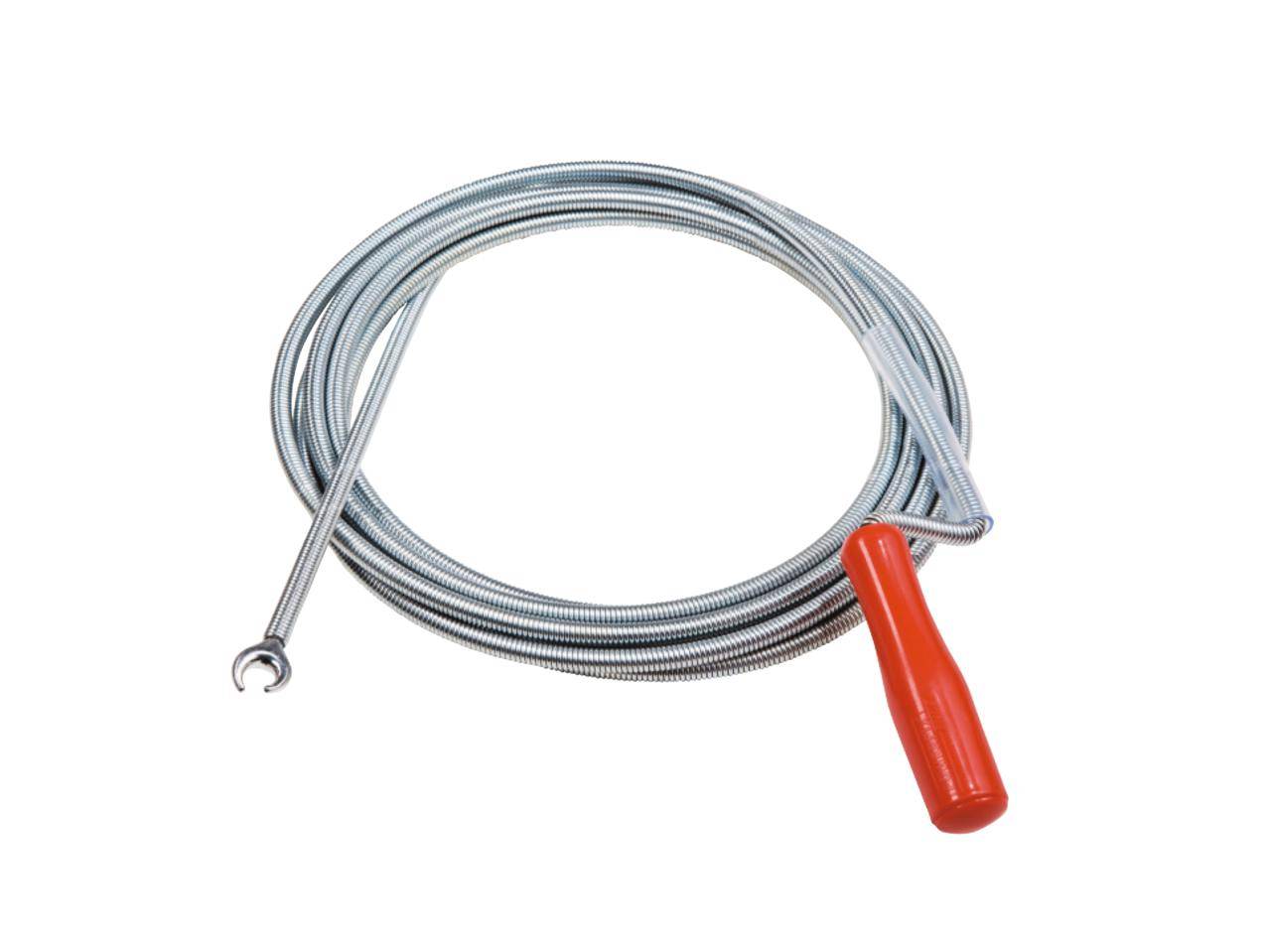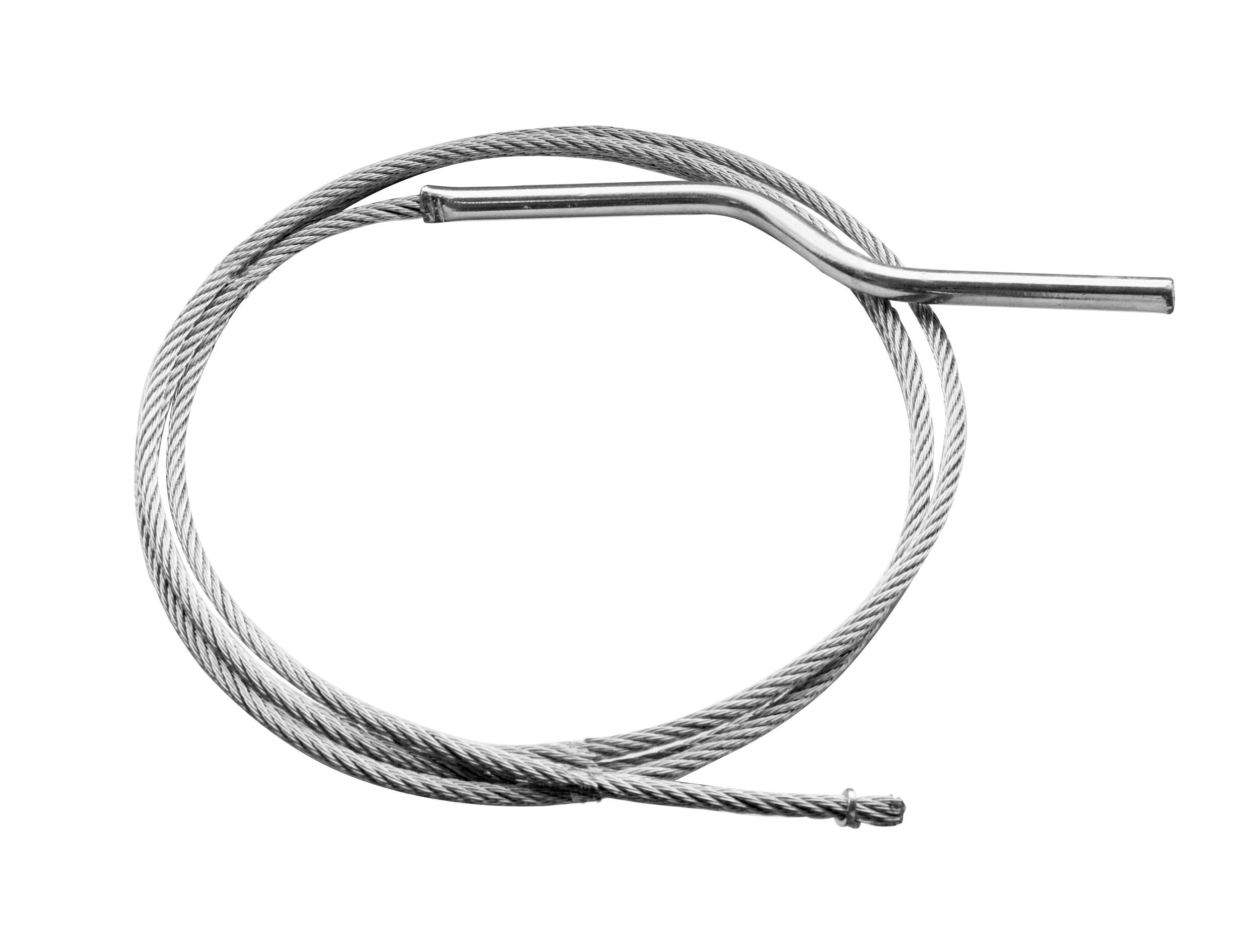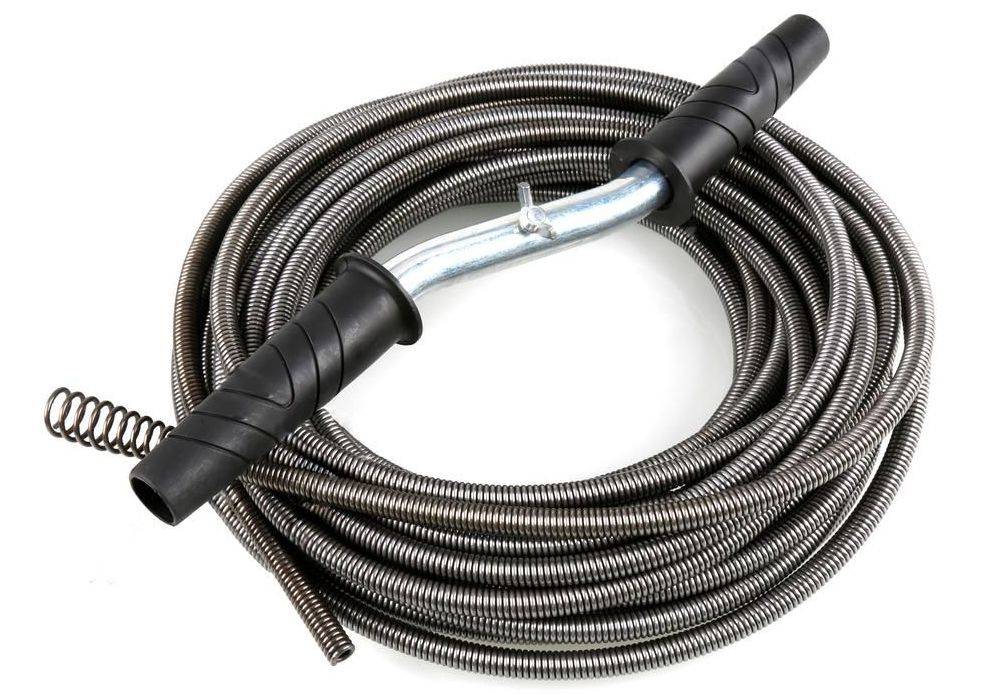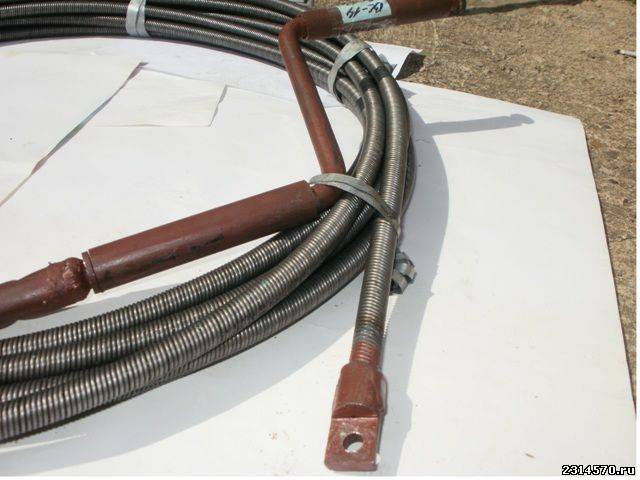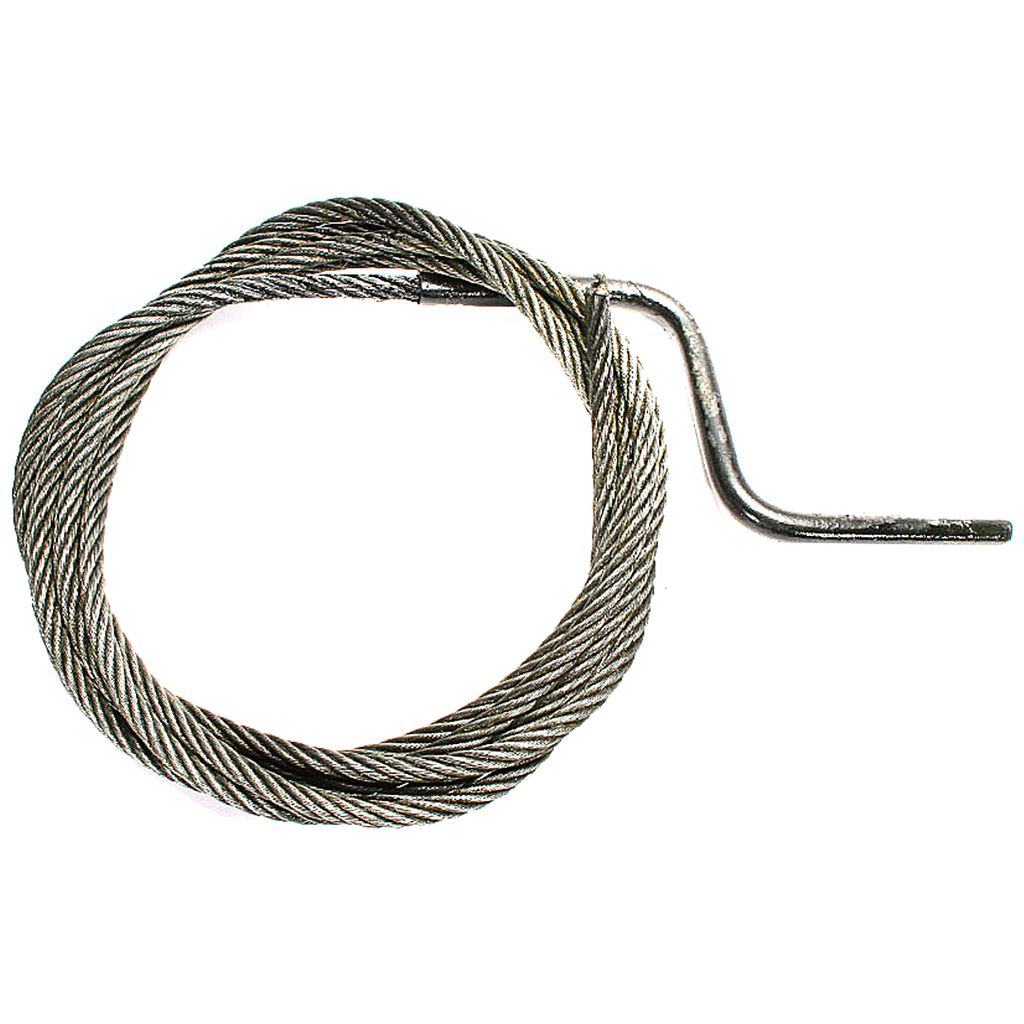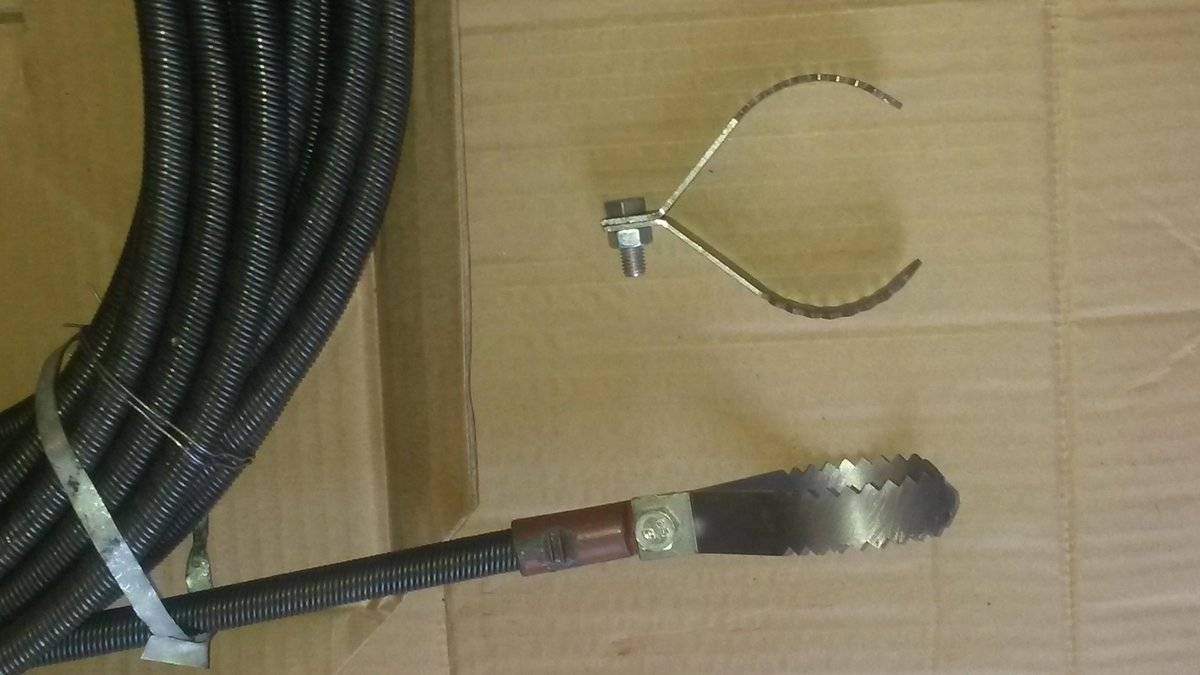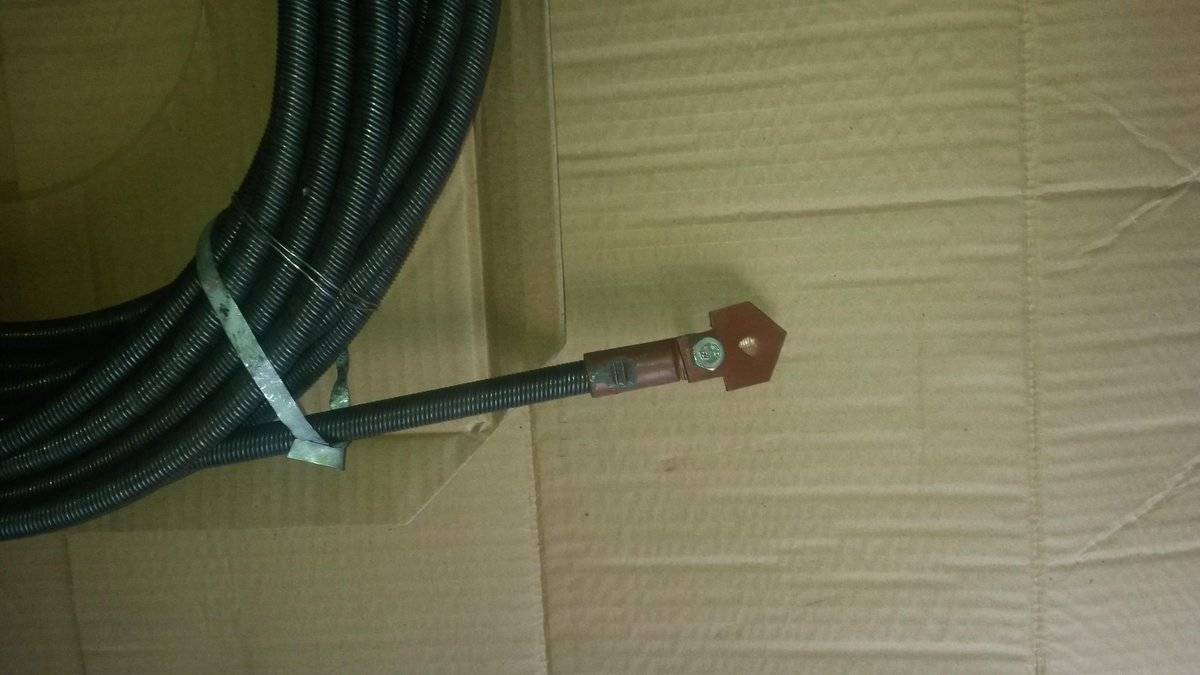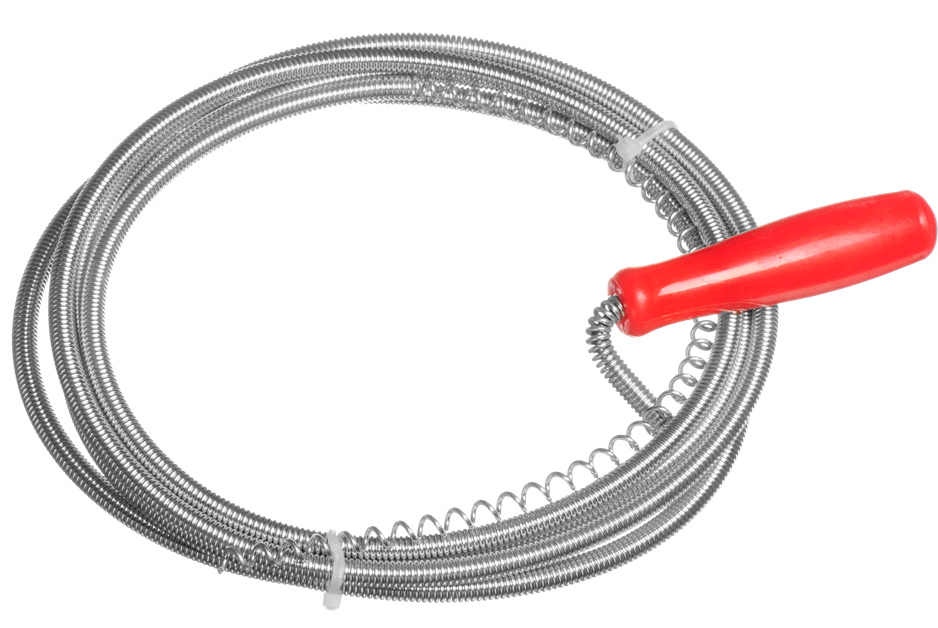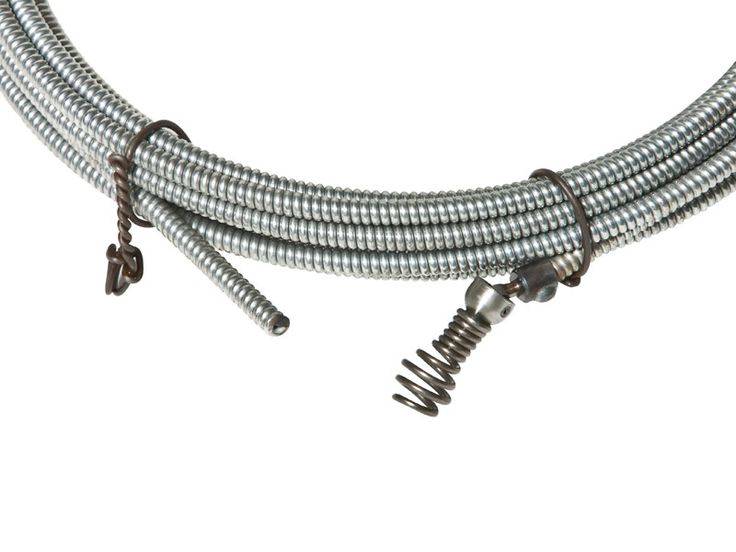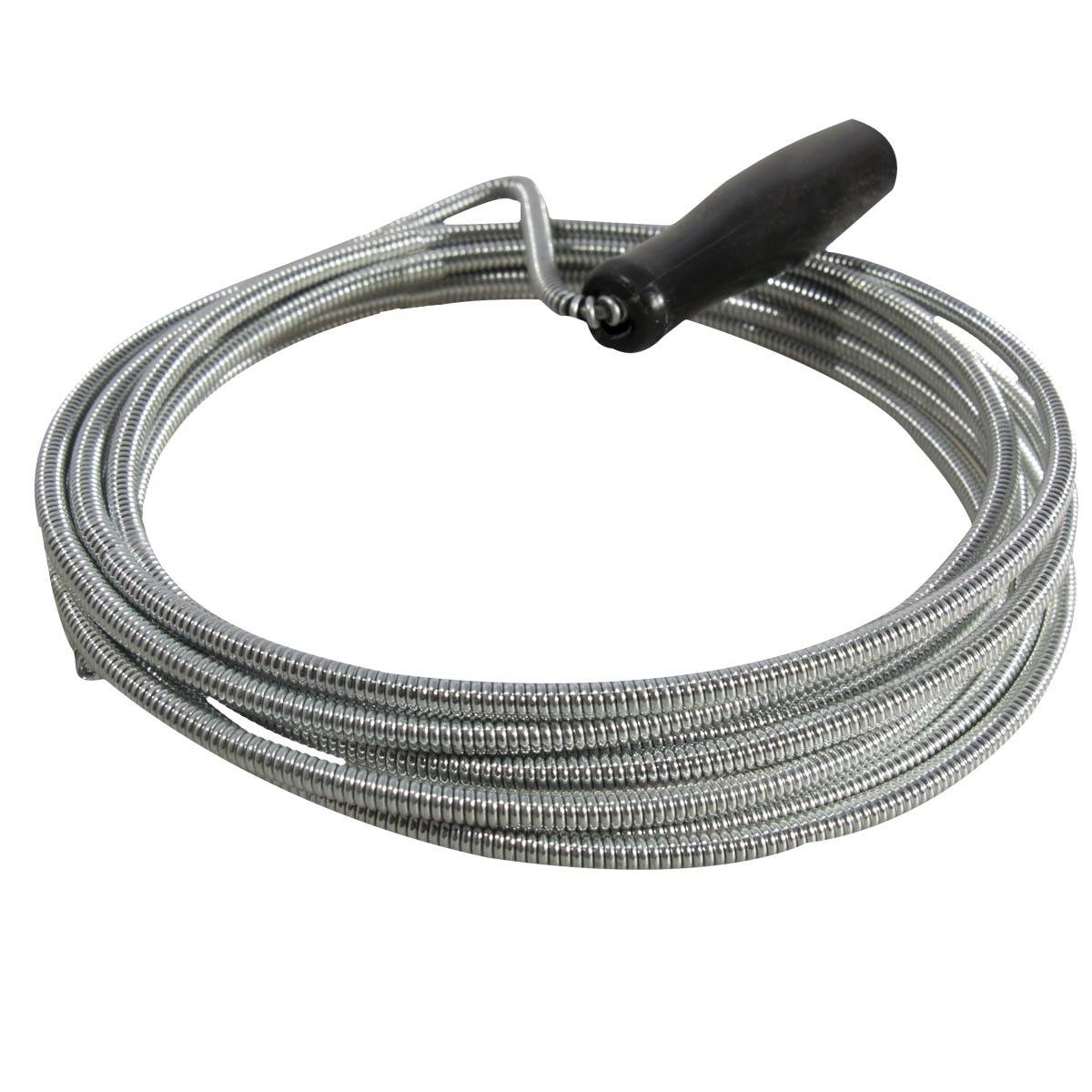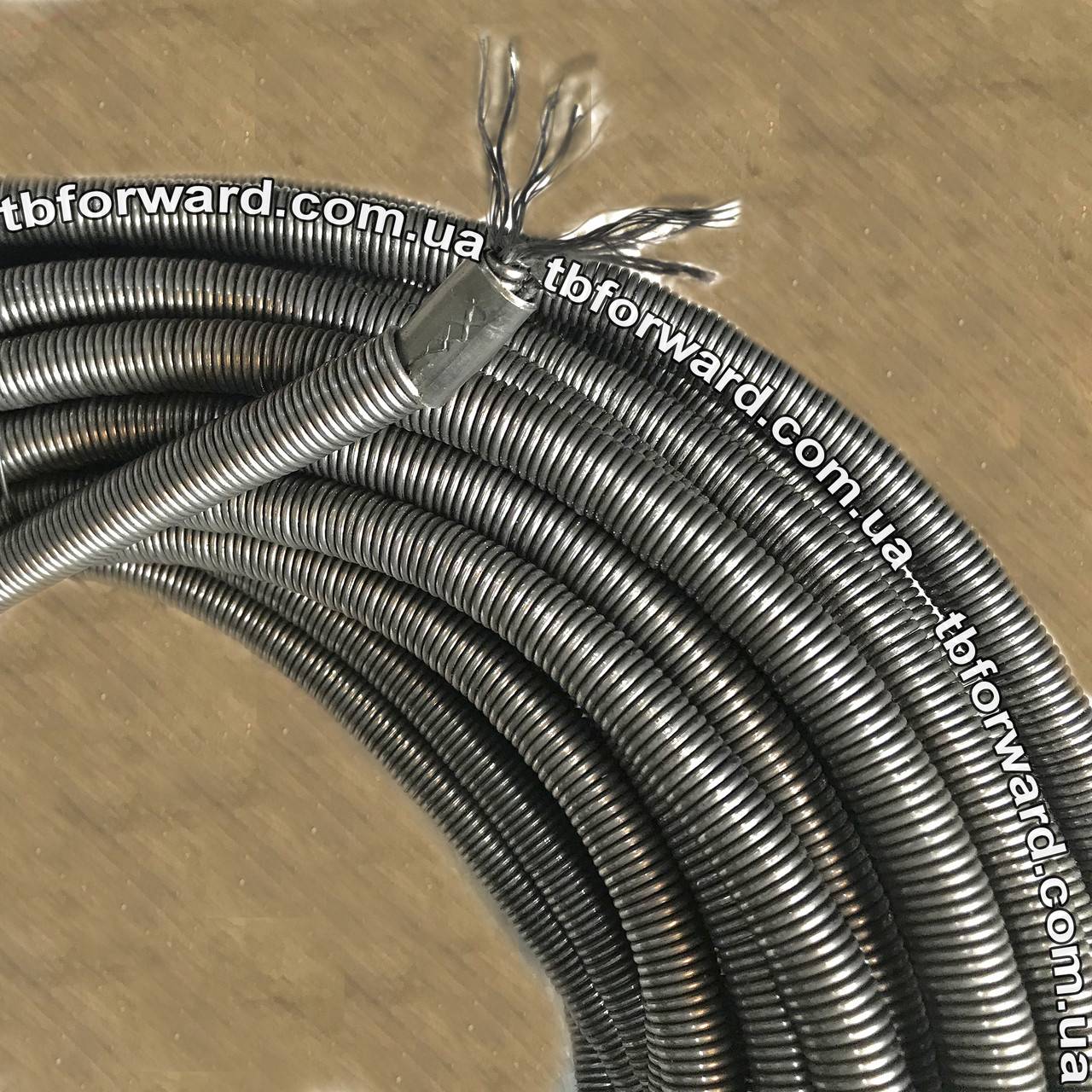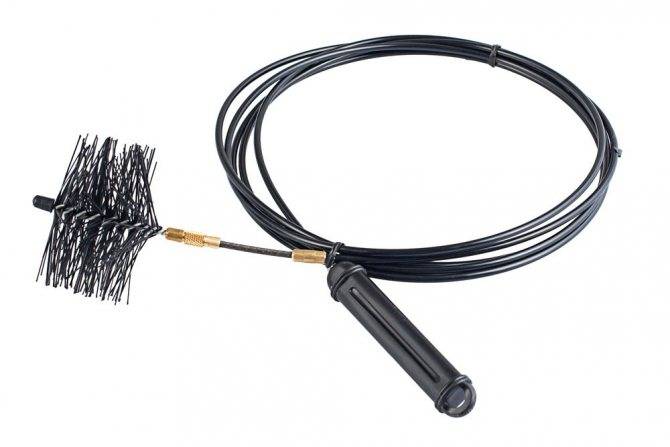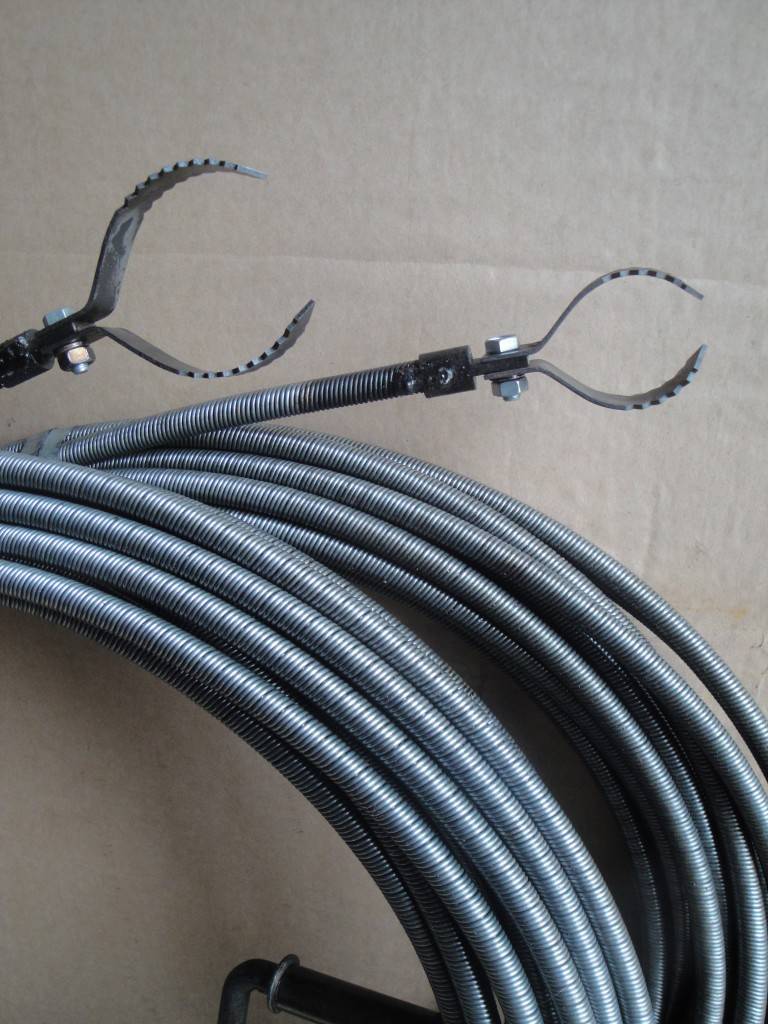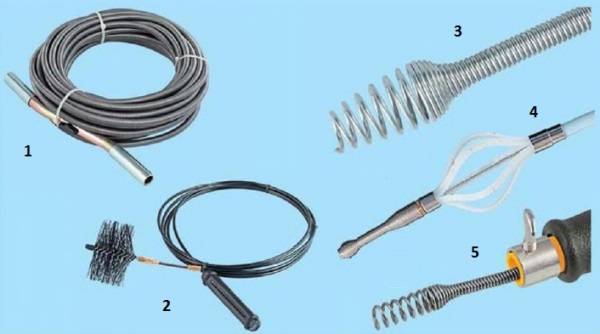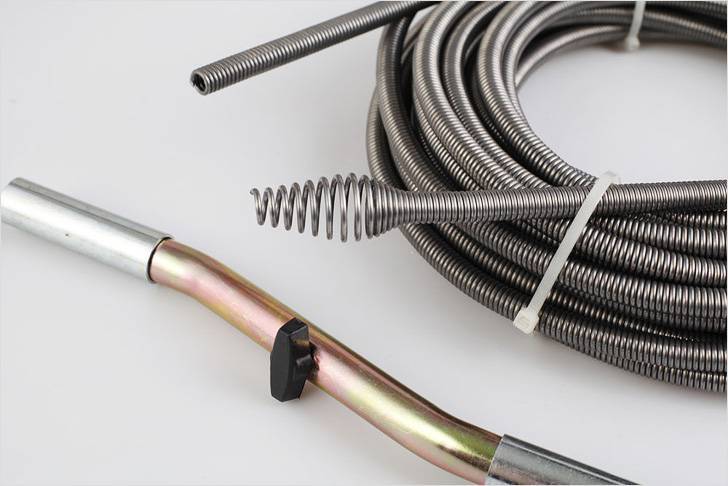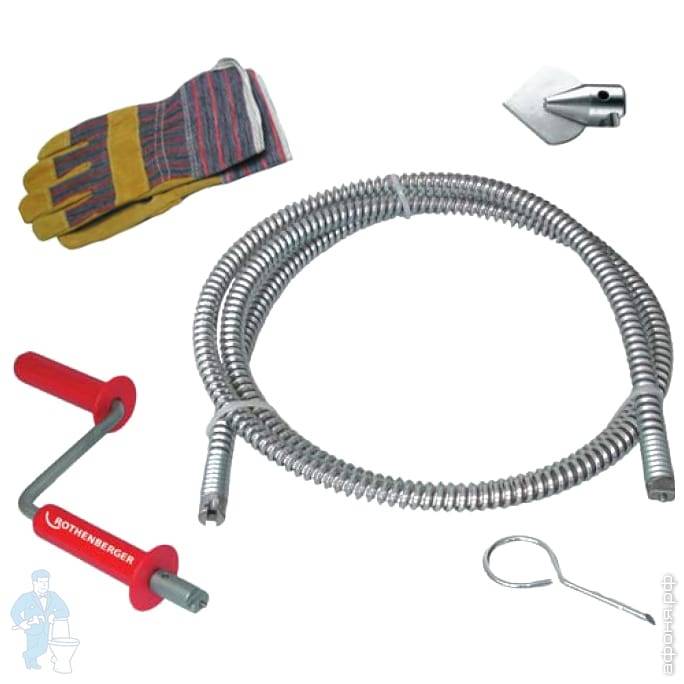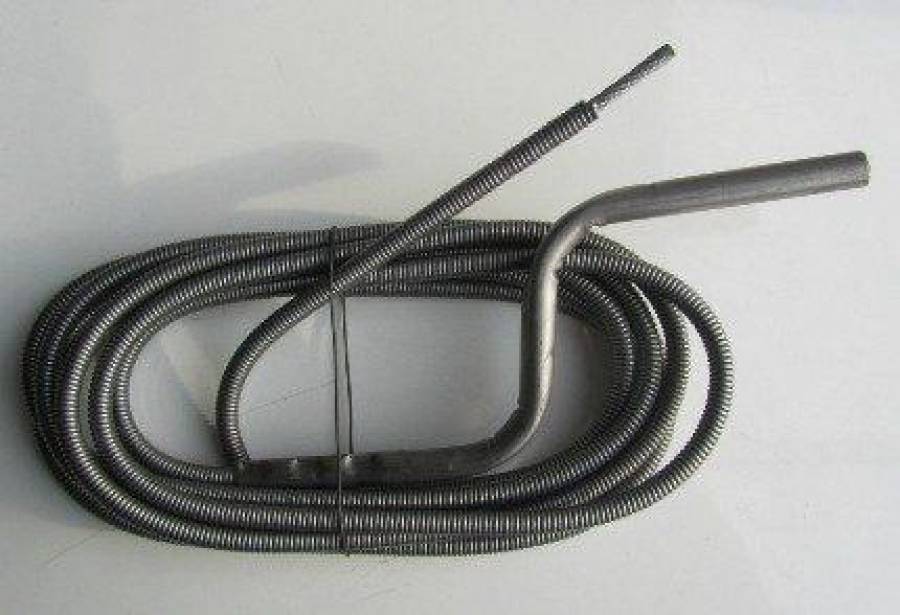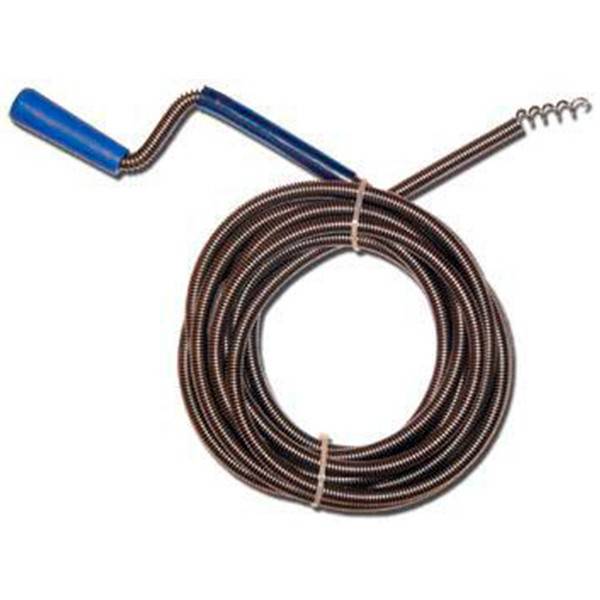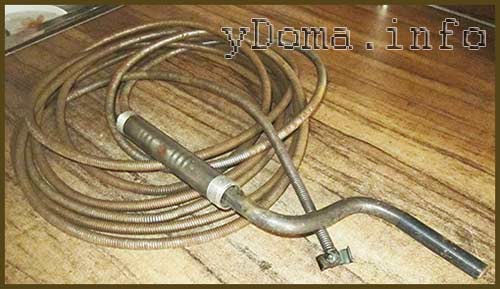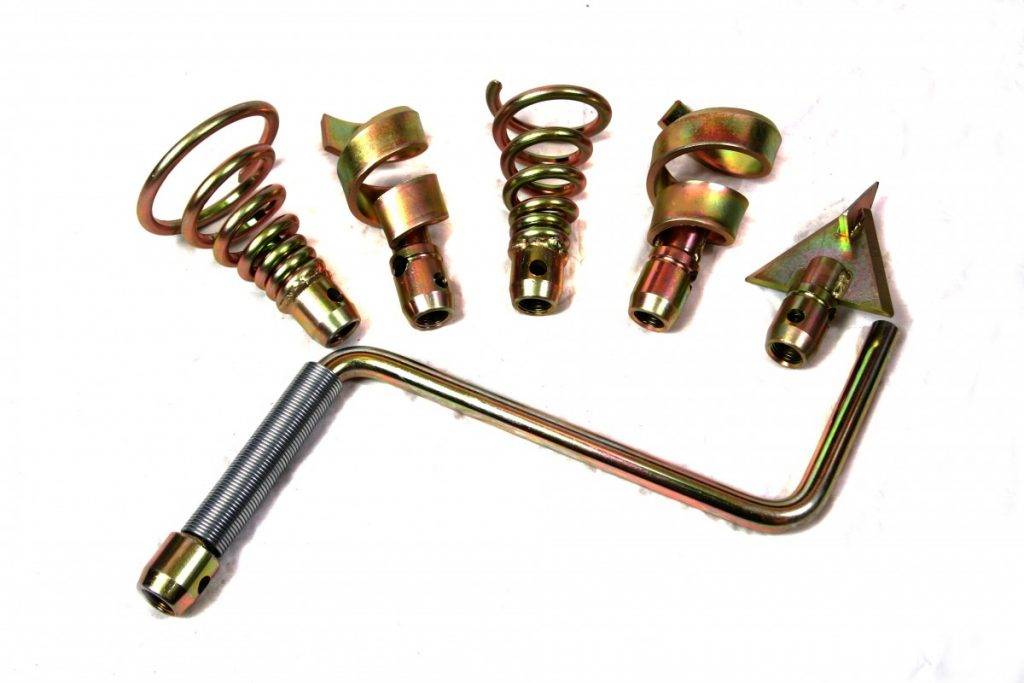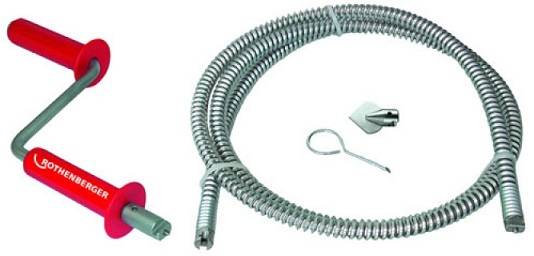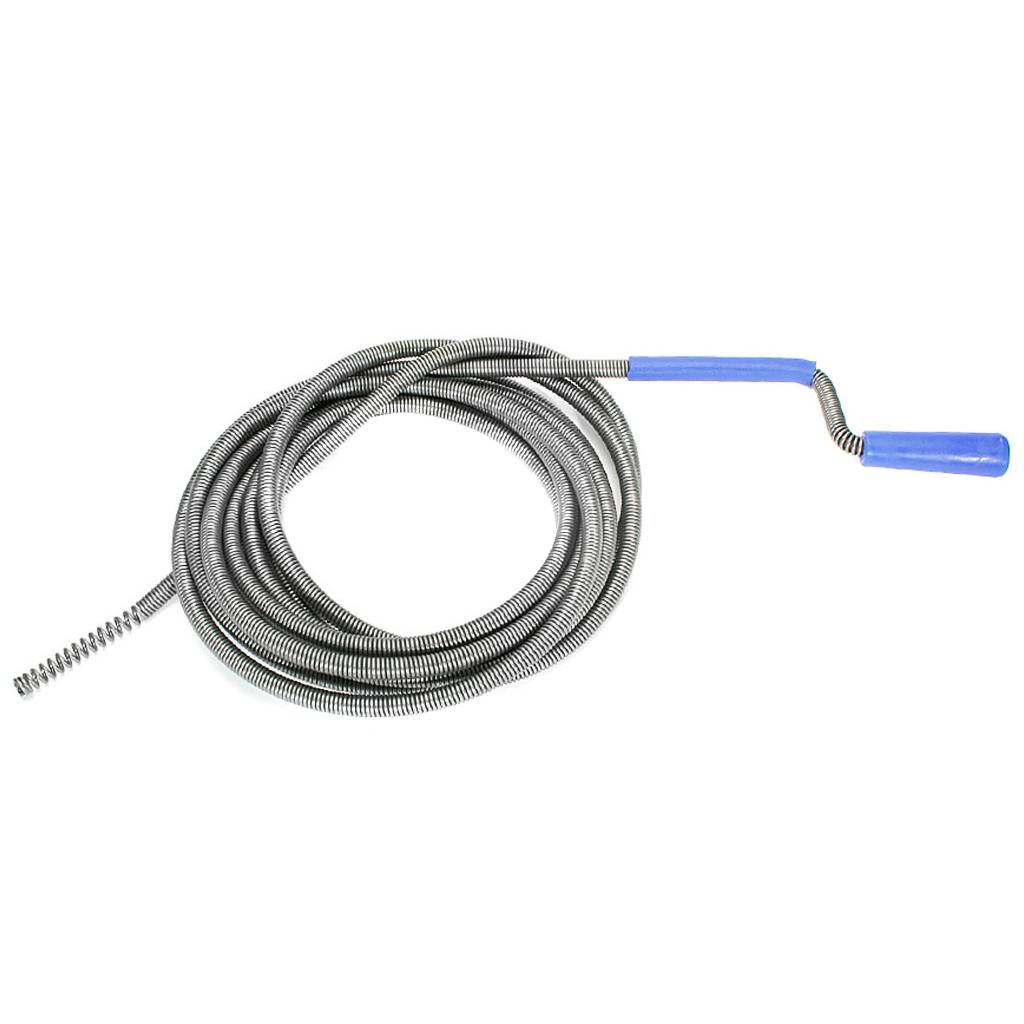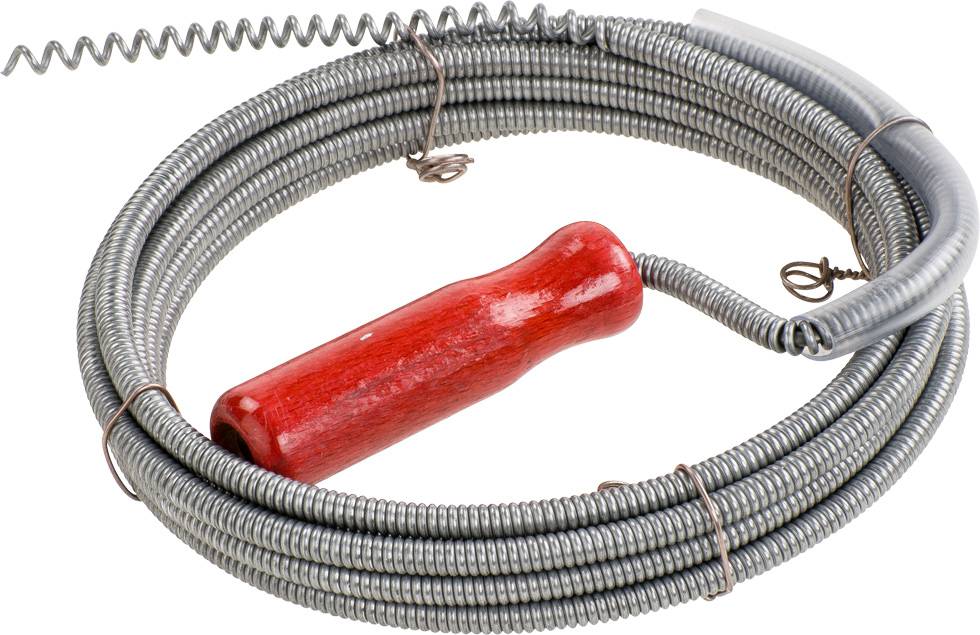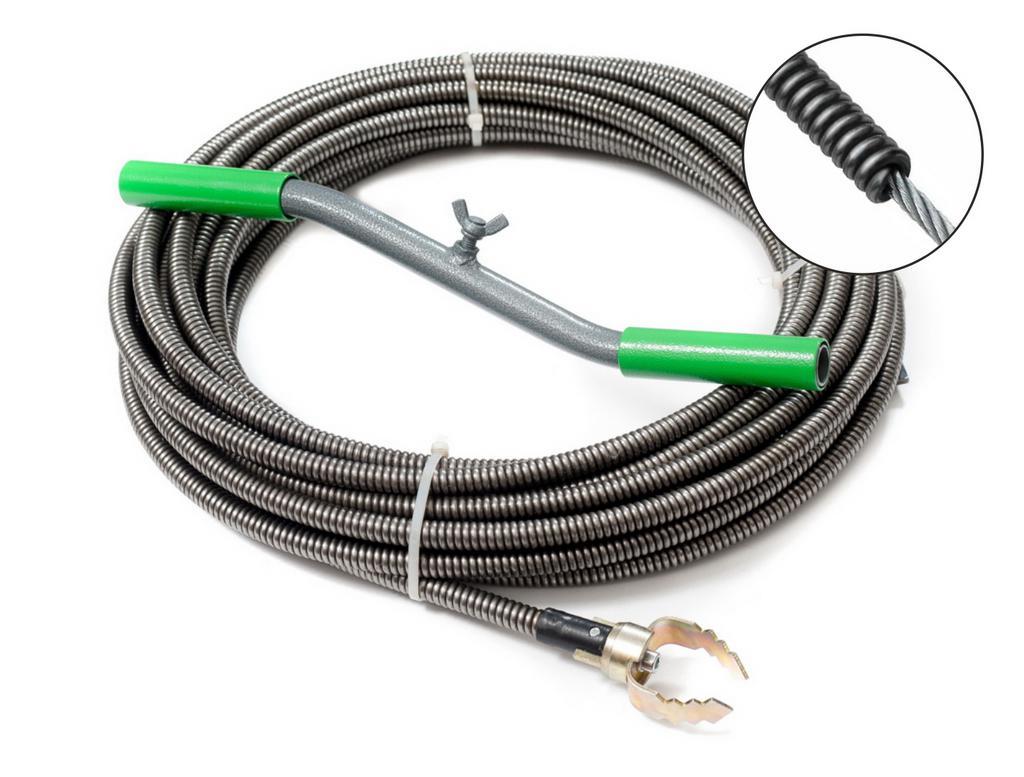Varieties of plumbing cables
The division of cables into types occurs according to their size - diameter, length. In addition, some products have additional attachments.
Common types of ropes, starting with the smallest:
- Galvanized steel rope cable for sewer cleaning with a diameter of 6 mm. It has strength, durability, sufficient flexibility. The standard length of such a cable is 5 m. The product is intended for use in apartments and private houses.
- A cable for cleaning sewers with a diameter of 9 mm, which is a hollow spiral. It is also considered a household tool.
- A product with a diameter of 13.5 mm and a length of 25 m is considered professional. It looks like a spiral made of spring wire (1.8 mm). One end is equipped with a curved handle. The cable is equally suitable for cleaning risers and removing blockages in horizontal pipes. There are similar products and small lengths, they are used to clean toilets.
- A rope with a diameter of 16 mm is a serious professional equipment. The center rod is wrapped in 3mm spring wire. The length of the cable is 60 m. The tensioning structure, if necessary, turns the flexible product into a rigid one, similar to a bar. Even the most difficult blockages cannot resist it.
"Advanced" masters advise to break the cable end crimped at the factory with a hammer to get a kind of brush. With its help, it is much easier to get out various garbage.
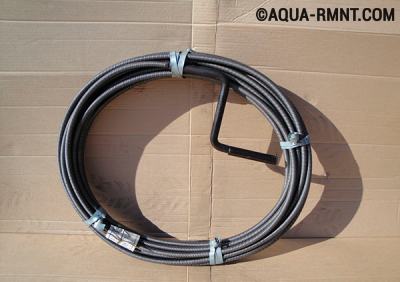
Simplest model for removing blockages - strong steel cable with a small handle for easy rotation
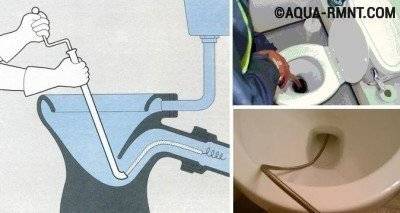
A cleaning cable for cleaning a sink or toilet works better than a plunger
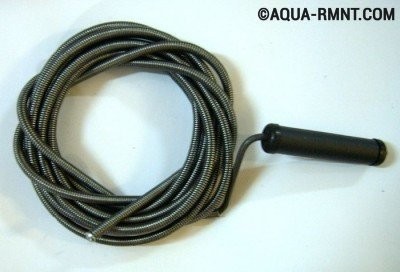
Spring cables are much stronger, more flexible and more functional than conventional steel cables
How to use the plumbing cable correctly
Complex blockages, a decrease in the diameter of the drain pipes due to long-term operation and the growth of a plug inside the drain require mechanical intervention. You can call a plumber for help or try to remove the blockage yourself.
The technology for using a sewer cable is as follows:
- The free end of the tool must be immersed in the drain hole.
- In a clockwise circular motion, push it as deep as possible to the place of the expected blockage.
- If the path passes through the corner pieces of the pipe, the device must be rotated using the comfortable handle.
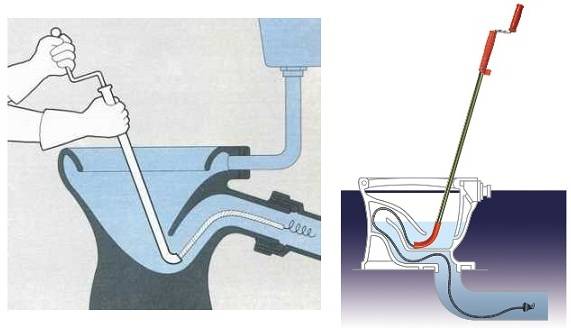
Using a plumbing cable
The pressure of the device on the blockage removes it completely or separates it into smaller particles, which are freely removed further down the drain system.
After removing coarse debris, it is recommended to drain a large amount of water through the system in order to eliminate the remaining plug completely.
For ease of use, special nozzles for plumbing tools can be used.
How to use the tool: step-by-step instructions
When working with plumbing equipment of this kind, all actions are carried out in the following order:
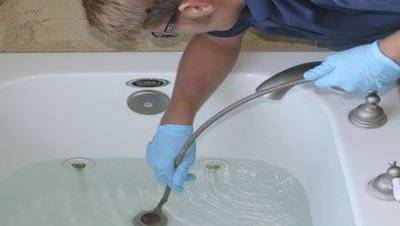
-
The preparatory stage is carried out before cleaning the sewer with a cable, and is performed as follows:
- the instrument must be inspected for integrity;
- it is checked how securely the handle is fastened;
- if necessary, the bushings in the handle are lubricated;
- the condition of the replaceable nozzles is checked, after which, if unsuitable elements are found, they are replaced with serviceable ones.
- How, in fact, to clean the sewer with a cable? Pipes are cleaned as follows:
- The siphon is removed from the sink - so the task will be easier.
- The end of the cable is inserted into the sewer pipe, the other is folded into a ring and taken into the palm of your hand.
- The cable is pulled inside the clogged channel, trying to perform unsharp forward movements, at the same time it is necessary to rotate its handle. So it is more convenient to overcome the turns that can meet inside on the path of the shaft. At the beginning of work, it is recommended to choose one direction and no longer try to change it.
- Remove the tool from the pipe from time to time and clean it of debris.
- When you encounter a blockage, start rotating the cable a little faster - this makes it easier to push it forward. If you have a snap-on hook, use it to catch debris - if possible, it is better to pull it out.
- After removing the blockage, open a hot water tap and rinse the cleaned channel - it is better to make the water pressure not very high at first and gradually increase.
At the end of the pipe cleaning, remove the tool from the pipe and rinse thoroughly in hot water with diluted detergent. Then the equipment must be dried, rolled into a ring and put away for storage.
Care and storage
The cable is bought for long-term operation. Metal will serve for many years, but, like all iron, it is haunted by the risk of rust. Modern ropes are treated with anti-corrosion compounds, but this does not help, since the main work is in the aquatic environment.
After finishing work, wipe the cable with a dry cloth from the main dirt. Then rinse in a bathtub with hot water. Be prepared for the fact that there will be a lot of dirt and then you will have to wash the bath, besides, a specific smell spreads.
For storage, place in a cardboard box or wrap in paper. The plastic bag should not be tightly rolled up, the rope is better stored outdoors.
It can be stored at subzero temperatures, but if the device is needed in winter, it must be kept in a warm room for 40-60 minutes for better flexibility. The best place is an insulated balcony or an interfloor storage room. Professionals store their tools in a room with all equipment.
Is it possible to make a plumbing cable from scrap materials with your own hands
If you can't buy a cable for cleaning sewer pipes, you can try to make such a useful device with your own hands. For this purpose, various materials at hand are suitable. We offer a master class on making a device from plastic bottles:
| Image | Description of work |
|---|---|
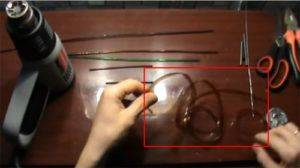 |
Cut out a tape 10 mm wide from a plastic bottle |
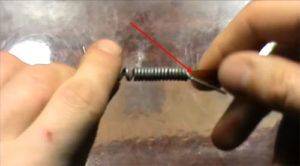 |
We insert the tape inside the spring. The inner circumference of the spring should be close to 10mm |
 |
We place the spring over the hair dryer, heated to 60 ° C, and begin to pull the tape. As a result, a tube is formed at the outlet of the spring. We make several tubes |
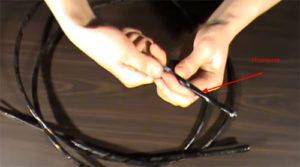 |
We connect several tubes together and wrap them with tape or electrical tape |
 |
Leave the small tip uncoiled to increase the efficiency of the fixture |
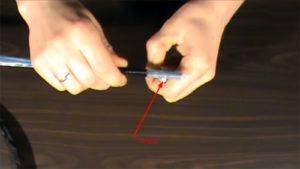 |
We heat the unwrinkled tip to give it the desired shape. You can use a lighter or a gas stove flame |
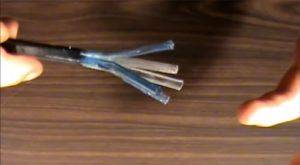 |
We give the ends of the trace the optimal shape. You can start removing the blockage |
If you don't feel like fiddling with plastic bottles, you can use a piece of metal cable. Its length should be at least a meter. Fluff one end to make a brush. The second, twisted into a ring, is used to attach the handle.
Rules for clearing blockages using a flexible shaft
The plumbing cable is an indispensable tool for removing large and small objects from the pipe that impede the outflow of water.
When cleaning pipes, it is important to pay attention to the following rules:
The handle of the cable should be rotated clockwise
This will increase the pressure on the blockage by compressing the spiral.
To remove the plug from plastic pipes, it is worth using rubber-braided cables so as not to damage the pipe walls.
Before starting work, it is important to inspect the cable so as not to overlook possible damage to the spiral. If they are not noticed in time, there is a possibility that the spiral inside the pipe will rupture, and then to get the broken end, you will need to dismantle part of the system.
If the cable is jammed, there is no need to make sudden jerking movements.
Calm, neat rotations in different directions will allow you to either pull the cable back, or push the plug in the place of the blockage.
After the pipe has been cleaned, it is better to additionally rinse the pipes with boiling water, and then pour in vinegar solution or some kind of cleaning agent.
In order to avoid blockages, it is worth taking care of prevention.
After use, rinse the rope with chemical cleaners and wipe up. Keep rolled up.
How to use a plumbing cable
The home drainage system is represented by a siphon connected to the drain hole of the sink, sink or bathtub, and a drain pipe that goes into the sewer riser. The siphon is characterized by a curved shape. They perform a water seal function that prevents the penetration of unpleasant sewer odors into the living space. In the process of using a plumbing cable, the following stages can be distinguished:
- Preliminary disconnection of the siphon, facilitating the opening of access to the drainage outlet. The siphon itself will need to be rinsed from the inside with hot water. A sealing plug is unscrewed on the outlet pipe.
- After unwinding the cable, it is introduced into the opening of the outlet pipe with the help of translational movements. The tool is pushed until it stops against the obstacle. A bend or butt joint of pipes can act as such an obstacle. Therefore, pull the cable back and repeat pushing while turning the cable handle. If, during this manipulation, the cable does not advance, it means that the cable has come to the blockage.
- Due to the reciprocating movements, the pushing of the cable continues with its simultaneous rotation using the handle. It is recommended to perform this manipulation together with the separation of pushing and rotational duties. When carrying out the procedure alone, it is recommended to use a cable with a longitudinally rotary handle.
- It is advisable to pour hot liquid into the pipe during cleaning, which will soften the blockage and facilitate the movement of the blockage. With the free passage of the clogged area with the cable, it should be removed from the pipe. The process ends with a strong pressure of hot water being lowered into the pipe. If at the same time a funnel is formed, then the cleaning measures have been carried out correctly and the blockage has been removed. In its absence, more thorough cleaning measures will be required.
How to make a cable yourself
You can make a cable with your own hands, using simple materials. This is done in several stages:
- you will need to purchase a small flexible iron rope;
- it is required to fluff up and bend its edge;
- to the other end of the cable, you will need to attach a ring, which will be needed in order to comfortably perform twisting movements during operation;
- in the middle, you need to fix a small piece of plastic pipe or wrap it with something solid for a comfortable hold.
Most often, blockages do not occur in the sewer pipes, but in the knees. In such a situation, it is better not to use an iron cable, since this will most likely lead to damage to the sewer system.
To avoid this, it is necessary to use a material that is not too hard and very flexible.
The cable, which will be used to solve such a problem, would be better made with your own hands from a plastic bottle. You will need to degrease the surface and make a spiral sketch, with a width of 2 cm, then cut out the shape according to the figure.
In order to be comfortable using this device - make a loop at the end. It is useful for securing the cable during the cleaning process. Cover the entire tape with small notches, so you can more effectively deal with blockages in the pipes.
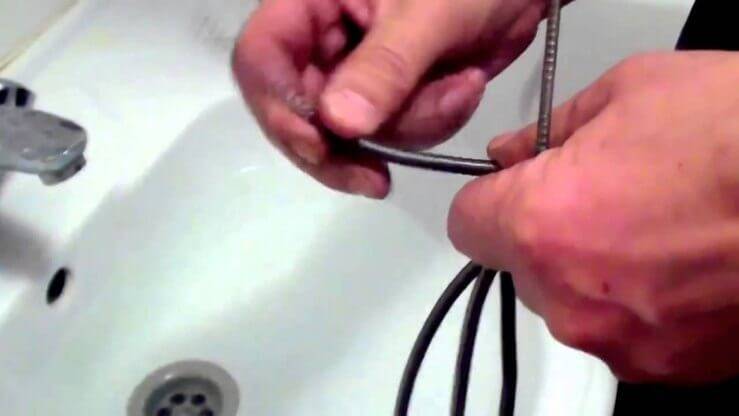
Types of sewer cleaning cables
Usually, devices for removing blockages are divided into several types, and each of them performs its own functions:
- rope type has a diameter of 6 mm. Galvanized steel is recognized as the basis of the product, since it is considered one of the most durable materials. The end of the device is usually crimped, but to improve cleaning, the plumbers break it up on their own, making a kind of ruff to make it easier to influence the debris in the pipeline. However, this device is not suitable for serious sewage problems, since it is considered soft enough, therefore, ideally, use a tensioner (see below);
- instead of an ordinary cable, a tool such as a metal tape can be used. Its length is usually about 20-25 meters, which makes it possible to operate the device for very long sewerage systems. Among the shortcomings, one can single out the fact that the tool cannot cope with deposits of fat and sludge in the sewer pipelines;
-
a rope for in the form of a flexible hose is considered a good substitute for a rope device. The inner part consists of a strong core, and the outer layer is made of a steel helix, which is often applied in several layers;
- The spring cable for cleaning the sewer is from 6 to 9 meters long, the inside consists of a strong steel spring, which adds reliability and strength to the device. This option is used for a household sewer system; a homemade ruff can also be made at its end;
- The tension cable for sewer cleaning has a convenient moving shaft. He, in turn, is entwined with wire, made in the form of a spring. A unit of this type is characterized as professional, since its capabilities include work with the most serious blockage in the pipes;
- the electric cable is also a special tool that makes it easy to remove all dirt without causing fatigue on your hands. The mechanism does its job on its own. All that is required of a person is only to manage the structure with his own hands. The tension version is also capable of working.
For home use, there are other types of devices: both a homemade tool and those used by professional plumbers.
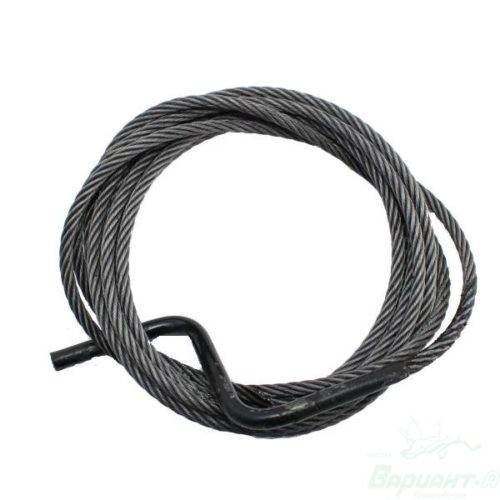
Rope sanitary cable
Varieties
There are several types of cables that have been improved by specialists. Each of the types is applicable to work with specific problems.
Cable cars
This is the simplest type of plumbing equipment that is suitable for removing the plug by the owners of an apartment in an apartment building. Description:
- is a cord tightly twisted from galvanized wires;
- the thickness is 6 millimeters, the length ranges from 1 to 5 meters.
The disadvantage of the rope is considered to be poor rotational ability, as well as the lack of elasticity of the material. The finish area of the rope exhibits the ability to loose fibers. Rope cobras are heavy and take up a lot of meta when folding. Moreover, they are wear-resistant and durable.

Spring loaded
This is a professional equipment, which is a construction of a steel core wrapped in twisted wire. The device has high indicators of mobility, demonstrates the highest possible penetration ability. The thickness of the cable reaches 3 centimeters, the length reaches 60 meters. There are 2 types of spring fixtures:
- Fixed center. The layers of wire are wound in different directions from each other, which provides a firm and tight bond.
- With a movable middle. A device in which a small space remains between the middle and the outer shell. Due to the presence of a hollow space, the tip is reliably covered along the entire path of the wire. The nozzle protrudes from the cable only when it hits the plug. This technique allows you to maintain penetration and increases the service life of the device.
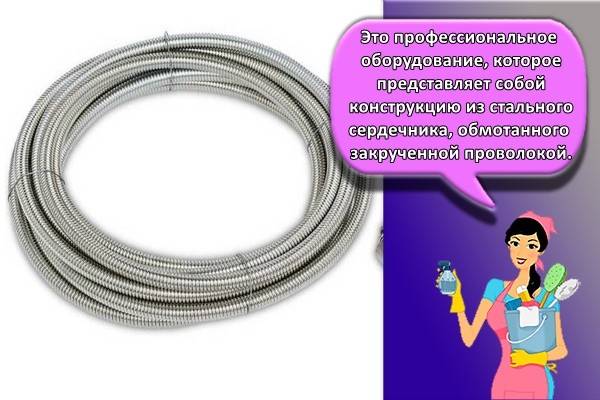
Spring-wound
Spring-wound cobras are suitable for home use. They are made from a thin metal cavity that is empty inside. The flexibility of spring-wound structures is an advantage and a disadvantage at the same time. The ability to pass through the winding sections of water pipes without tension leads to the fact that the torso inside the pipe bends, makes loops, and gets tangled.

Tape
The flat, hardened metal strip with a ferrule exhibits a high penetration capacity. The tape removes hard plugs, cleans up construction debris. The thickness of the tape is 4 millimeters. The tip of the tape is built-in in advance; most often it is a pointed lance that is capable of breaking through a tight plug. The tape does not adapt well to pipe bends, as it does not have sufficient flexibility. In addition, it should be borne in mind that with the help of the tape it is impossible to reach the blockage or parts of the jammed debris.
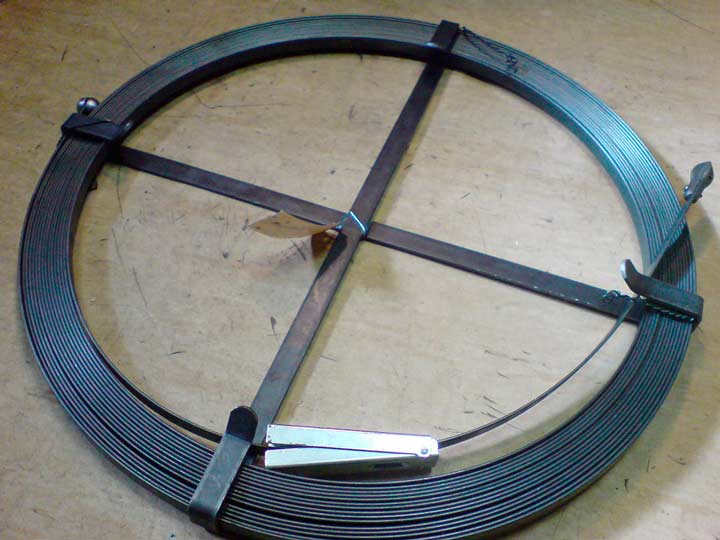
Electric
Electric drum models are automatic cable feed devices. Electrical equipment is professional equipment intended for professionals. They work on the principle of unwinding a coil. The feed speed of some models is adjusted by installing a lever on the drum body.

Criterias of choice
Each cable is designed to clean the sewer pipes in which the blockage has formed. On the modern market there is a fairly diverse range of these products, which differ in individual parameters and purpose.
To make the right choice, it is recommended to take into account their technical features.
Diameter. Based on the parameters of the sewer pipes, it is necessary to select the cable
In this case, it is important that this device moves freely through the system, pushing the formed plug.
Length. The length of the spiral will directly determine the depth to which the device can descend.
A pen
It can have an L-shaped or Z-shaped handle.
The presence of a braid. The plastic braid protects the pipes from damage while clearing the blockage. It is especially relevant in the sewer system, which consists of modern plastic pipes.
Material. The best option is a stainless steel cable, which is characterized by durability and resistance to adverse factors. This material perfectly retains its qualities even after repeated use, as it is characterized by increased wear resistance.
Rigidity. The higher the level of rigidity of the product, the more convenient it is to use it during cleaning.
Device type. It is recommended to choose a cable taking into account the peculiarities of its further operation.
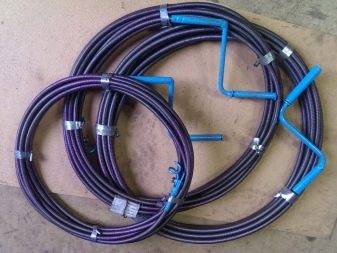
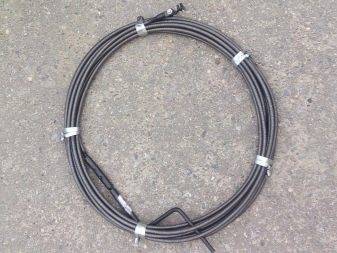
When purchasing a cable, you should carefully choose its cross section. In most cases, it is the correctly selected section that ensures quick and effective elimination of blockages, as well as maintaining the integrity of the sewer system.
An individual version of this device is provided for each pipe diameter:
- up to 50 mm - section no more than 10 mm;
- 50-110 mm - section within 11-15 mm;
- more than 100 mm - section from 16 mm.
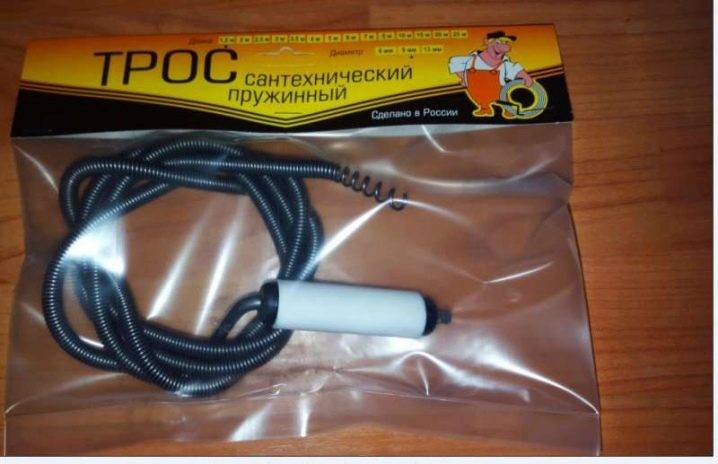
It is necessary to take into account the fact that a cable that is too thin with a cross section of about 4 mm can break during use, so this option can be used exclusively for hair removal in plums. A spring cable is considered more professional. Its length starts from 25 meters and can reach 60 meters. The diameter of this instance is 13.5 or 16 mm.This option is more functional and effective, due to which it has a wide range of applications.
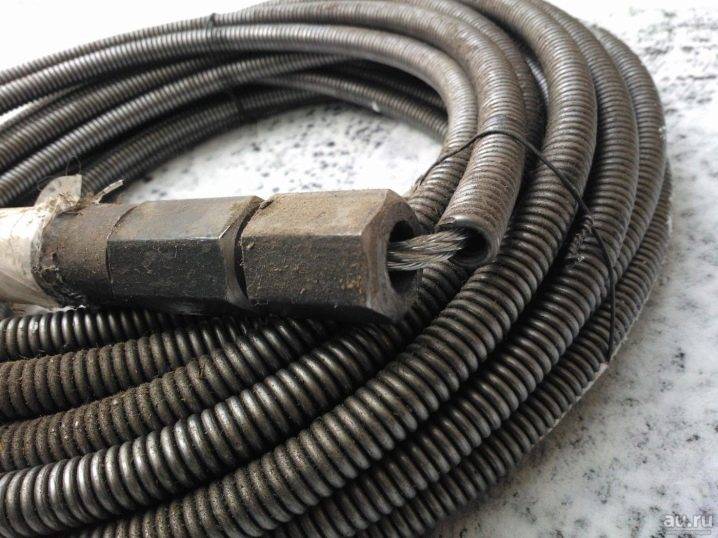
Sewer pipe cleaning nozzles
There is a hook at the end of the plumbing cable. It allows you to pry on the trash plug. Such a tip is not always able to effectively deal with the blockage. By replacing the hook with a special nozzle, you can quickly clean the pipe. Installation is carried out by means of a threaded connection.
The attachments can be purchased with or separately from the flex shaft. The following can act as a nozzle:
- a brush that cleans the inner wall;
- pear-shaped nozzle;
- wide pipe expander;
- auger that allows you to remove solid deposits from the inner surface of the pipes;
- a scraper capable of dealing with sediment on thick pipes;
- a harpoon to help pick up and remove the plug;
- an expanding knife that cleans the pipe walls;
- a lance used to break up fat build-ups.
There are other devices that can perform this function.
How to understand that the pipe is clogged
The first concern should be the water that gets trapped in the sink. This is a signal that something is wrong with the lumen of the pipe. If an unpleasant smell has already gone through the house, then there is nowhere to hesitate. Stretch out more time - and it is possible that you will not be able to do it on your own. We'll have to resort to the help of plumbers and fork out for their expensive services.
Why could such a nuisance happen? It seems that all the safety measures have been taken: there is a filter grate on the sink, a paper basket in the toilet, everyone uses the plumbing very carefully. Perhaps the blockage is not even your fault: it's all about old cast-iron pipes with an uneven inner surface.
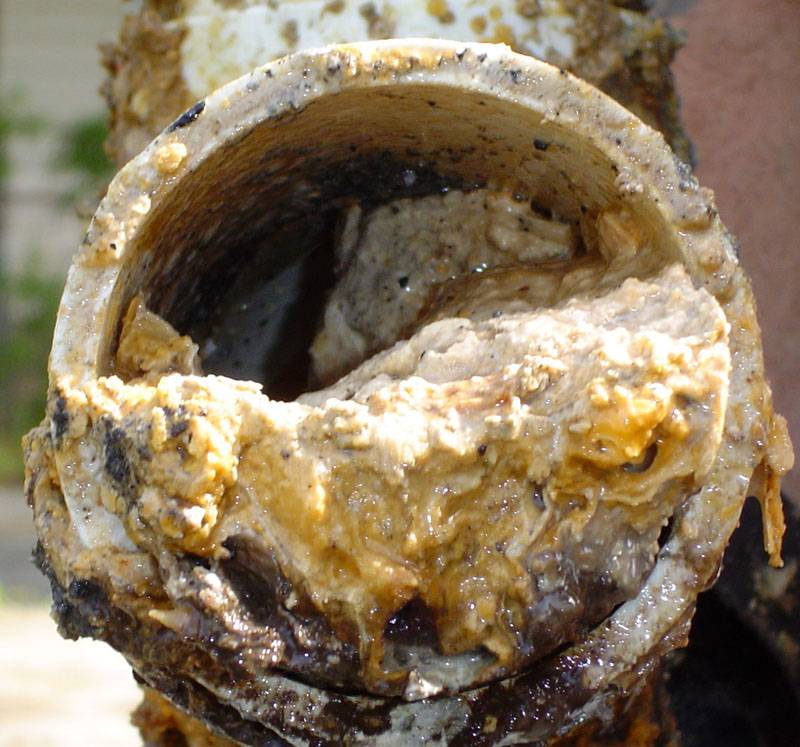 Rough walls of the sewer trap the contents of the drains and "overgrow", over time the lumen becomes smaller and disappears altogether
Rough walls of the sewer trap the contents of the drains and "overgrow", over time the lumen becomes smaller and disappears altogether
Another possible reason is errors in the design of the sewer system as a whole. Incorrect angle of inclination of the pipe, possible joints and turns - all this can lead to the formation of a plug.
Is there any way to prevent blockages? Of course, if you take preventive measures from time to time, you may not need to do the dirty work at all. What can be done:
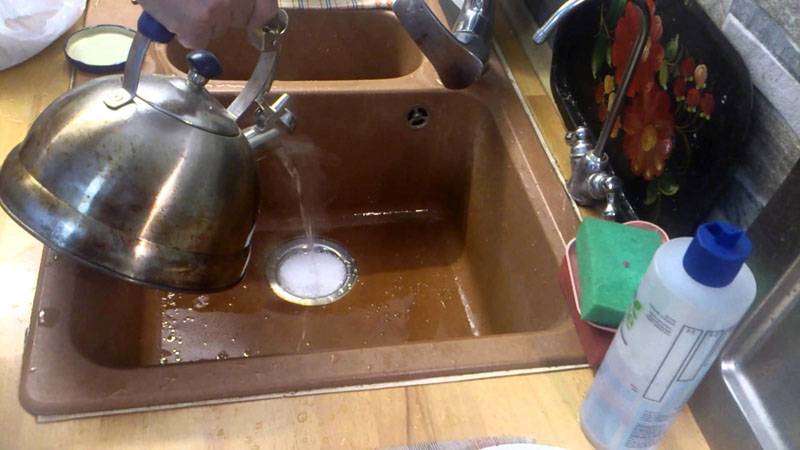 The hotter the water, the more effective the procedure
The hotter the water, the more effective the procedure
- Use a soda solution. To clean the sewage system and eliminate unpleasant odors, you need to pour soda into the drain and pour boiling water over it. The alkali will quickly dissolve the fat layer.
- Apply a solution of baking soda and vinegar. This is a more radical way of cleaning, but it is guaranteed to help in a difficult situation. You should pour about a third of a pack of soda into the drain and pour half a glass of table vinegar. To prevent foam from spilling into the ceiling, be sure to quickly plug the hole in the sink with a stopper. After a quarter of an hour after that, pour boiling water over the pipes.
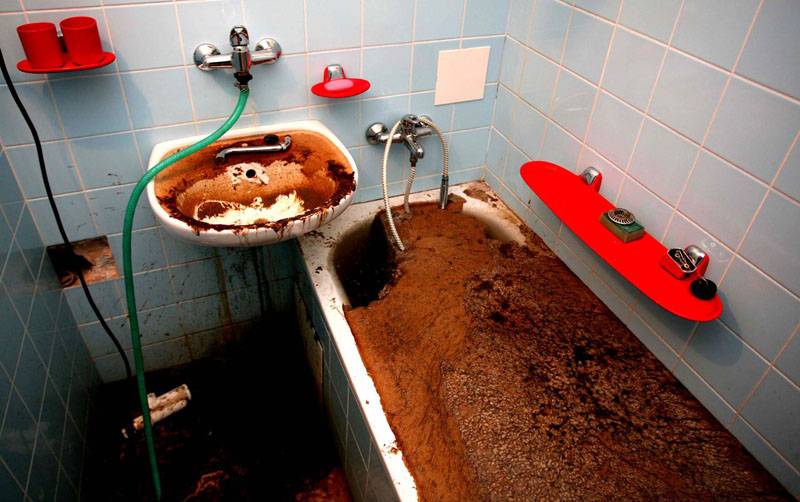 All of the above methods are preventive, they will not help if the plug has already formed.
All of the above methods are preventive, they will not help if the plug has already formed.
Basic parameters when choosing a cable
What should you first of all pay attention to when buying one or another plumbing cable?
First of all, of course, on its thickness. It depends on this parameter how strong blockages can be eliminated with its help. For an ordinary user "behind the eyes" a diameter of 5 to 9 millimeters is enough. For more stubborn blockages, it is recommended to pick up a thicker cable.
The material from which the rope is made. In any case, it must be stainless steel or iron treated with a stainless steel coating. After all, you have to work with an aqueous medium, and as you know, it is the worst enemy of any metal.
Length. Typically, for home use, it is 5 meters. In some cases it can reach and 9. This is quite enough for most cases. Professional equipment assumes a cable length of up to 60 meters.
Spring presence
Thanks to this, it will be possible to push the blockages more intensively.
It is also worth paying attention to the possibility of arranging certain devices at the end of the cable. These can be various brushes, brushes, drills, pear-shaped nozzles, etc.
For its type of blockage, certain types of nozzles are used. However, it is better to consult a specialist which nozzle to use in this or that case.
Selection of tools by diameter
When working with plumbing equipment of this kind, all actions are carried out in the following order:
-
The preparatory stage is carried out before cleaning the sewer with a cable, and is performed as follows:
- the instrument must be inspected for integrity;
- it is checked how securely the handle is fastened;
- if necessary, the bushings in the handle are lubricated;
- the condition of the replaceable nozzles is checked, after which, if unsuitable elements are found, they are replaced with serviceable ones.
- How, in fact, to clean the sewer with a cable? Pipes are cleaned as follows:
- The siphon is removed from the sink - so the task will be easier.
- The end of the cable is inserted into the sewer pipe, the other is folded into a ring and taken into the palm of your hand.
- The cable is pulled inside the clogged channel, trying to perform unsharp forward movements, at the same time it is necessary to rotate its handle. So it is more convenient to overcome the turns that can meet inside on the path of the shaft. At the beginning of work, it is recommended to choose one direction and no longer try to change it.
- Remove the tool from the pipe from time to time and clean it of debris.
- When you encounter a blockage, start rotating the cable a little faster - this makes it easier to push it forward. If you have a snap-on hook, use it to catch debris - if possible, it is better to pull it out.
- After removing the blockage, open a hot water tap and rinse the cleaned channel - it is better to make the water pressure not very high at first and gradually increase.
At the end of the pipe cleaning, remove the tool from the pipe and rinse thoroughly in hot water with diluted detergent. Then the equipment must be dried, rolled into a ring and put away for storage.
One of the important criteria for choosing a plumbing cable is its cross section. It should be remembered that thick instruments make it difficult to clean sinks or urinals; they simply cannot pass into the drain hole of the plumbing fixture. Use thick tools to free risers and large-diameter pipes from blockages.
Experts recommend using the following data when choosing a flexible shaft:
- If the pipe diameter does not exceed 5 cm, then the section of the sewer cleaning cable should not exceed 1 cm.
- Pipelines with a diameter of 5 to 11 cm are cleaned with a cable, the cross-section of which is 1.1-1.5 cm.
- It is recommended to clean a vertical riser with a diameter of more than 10 cm with a tool with a cross section of more than 1.6 cm.
Additional equipment and attachments
To improve the work, the cables are supplied with special technical equipment, you can buy a set or buy in addition later
But not all cables are suitable for attachments, when buying a cable, pay attention to this
- the reel for winding the cable is suitable for large, professional objects;
- nozzles for removing various types of garbage;
- electric twist for twisting and unwinding.
Correctly selected nozzles allow you to pull out any debris from the pipe. They are screwed tightly onto the end of the cable, and then work continues as usual.
- hook, pulls out fibrous or thread debris well;
- the loop, the most common type, is made of steel wire;
- brush, it can be of different lengths, works well on operational blockages;
- spear, breaks through complex congestion.
When buying, you need to specify the size of the attachment and your cable, as well as the method of fastening.Experienced plumbers make the attachments themselves.
How to make a cable with your own hands
As you can see from the description above, a steel cord with a length of at least 5 meters is required. For maximum efficiency, one end is equipped with a curved handle for scrolling inside the pipes, and the other end is broken with a powerful hammer blow, turning into a sharp brush.
This brush is called a tip, it can damage the plug and push it further down the pipe, freeing the passage.
For greater efficiency of the mechanism, the core can be wrapped in a spiral, for which a rigid wire is used. It must be firmly fixed.
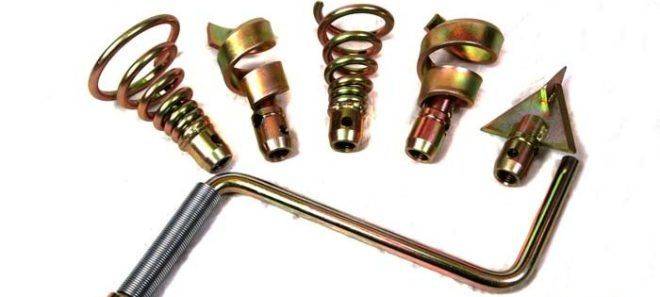 A set of special cable attachments for cleaning
A set of special cable attachments for cleaning
For DIY manufacturing, use only reliable and durable metal. If it is damaged in the process of moving along the pipe, it will be possible to get it only by dismantling most of the sewer pipes.
How to choose the right plumbing cable
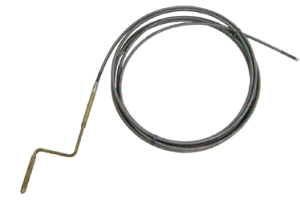
There are several types of steel cables that can be used as a plumbing cable for clearing blockages: rope, spring (also called spring-twisted, made in the form of a hollow steel spring) and flexible shafts.
Flexible shafts are one of the most effective for cleaning pipes and sewers. They remain straight (statically stressed) as they rotate, so they can easily break through blockages, and yet are flexible enough to go through all corners. It is such a steel cable (flexible shaft, also called "vibration cable") that is supplied to Belarus from a Russian manufacturer, is available in a warehouse in Minsk.
So, what you need to pay attention to first of all when buying a plumbing cable:
When choosing a plumbing cable, pay attention to its diameter, strength and flexibility. The cable is chosen depending on the diameter of the pipes and the distance that needs to be cleaned. It must move freely in a water supply or sewer pipe
If the cable is close to the walls, then it will not be able to go through the corners in which the pipes change direction. Also take into account: if the length of the pipe is a large blockage at a distance, then you will not be able to cope with the plug with a plumbing cable of a small diameter. plumbing cable with a diameter of 6 mm or 8 mm. For sewerage use a cable with a diameter of 14 mm or 16 mm. Consider, the larger the diameter and length of the plumbing cable, the more it weighs.
You can find out what the available diameters and lengths of the plumbing cable are here.
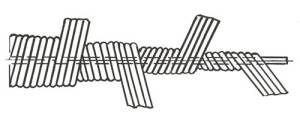
Also, when choosing a plumbing cable, pay attention to its strength. A high-quality pipe cleaning cable must have good strength characteristics.
The cable, which you can buy from us, is made of high-strength steel. For maximum strength, several layers of winding are wound on the steel rod (base). In this case, each layer of the winding changes its direction (clockwise and counterclockwise).
For all its high strength characteristics, the plumbing cable must remain flexible to fit the corners along the entire length of the pipes. Our wire rope is made of hardened steel, which gives it flexibility without sacrificing strength. Moreover, such a plumbing cable can even be cut into pieces, and at the same time it will not unwind.
Such a plumbing cable is used by all housing and communal services, emergency services, in administrative, office buildings. Also, the cable is used for cleaning sewers, water pipes, gutters in apartments, country houses, cottages, etc.
We work not only with organizations, but also individuals. By purchasing a plumbing cable (sometimes it is also called a "sewer cable"), you will save money on the work of plumbers of housing and communal services or housing and communal services.
How to clean pipes with a wire rope?
Preparatory stage
Before you start cleaning pipes from blockages, you must:
- Carefully inspect the plumbing equipment from all sides, in case of any mechanical damage.
- Check whether the handle is securely fastened.
- It is advisable to lubricate the bushings that are part of the cable handle.
- If there are nozzles, check their condition and replace the damaged ones.
Pipe cleaning work
The siphon must be removed from the sink, this will facilitate the work of cleaning the sewer pipes;
Insert the end of the cable into the hole in the pipe, and grip the other end in your hand.
Make forward movements, at the same time rotate the cable with the handle. These actions will help to make it easier for the rope to overcome all the bends in the pipe. During operation, it is impossible to press very hard on the cable, as you can damage the inner surface of the plastic pipe or damage the equipment
The condition is important when the cable rotates - it must be in one direction all the time, the direction of rotation does not change until the end of one direction of work. From time to time it is necessary to pull the cable out of the pipe hole and clean it from adhering dirt;
When the cable has reached a blockage, it is necessary to increase its rotation.
It may be possible to push the blockage forward, but if you have a special nozzle in the form of a hook, you need to pick up and remove the debris from the pipe. The pipe is cleaned qualitatively if the water, draining, forms a funnel;
After removing the blockage, it is advisable to rinse the pipes first with a weak pressure of boiling water, then with a large one.
Completion stage
At the end of all work related to cleaning the sewer systems, it is necessary to rinse the plumbing cable with special care in hot water using a detergent. Then dry all the fixtures, then roll them up and place them in storage.
To clean the sewer pipes, you can use other methods: plunger, boiling water, vinegar with soda and various modern means. But, so far nothing has been invented better than the old proven method of cleaning the sewer with a steel cable.
Choosing a cable for cleaning sewer pipes: the dependence of the thickness on the diameter of the pipeline
A competent choice of section will ensure high-quality performance of work. A tool that is too thick will prevent you from cleaning your urinal or sink. It will be difficult to lower it into the drain hole. Although with pipes of a larger diameter and a riser, it will cope quite well.
Manufacturers offer to buy a plumbing cable with a diameter of 3–32 mm and a length of 1.5–90 m. For domestic purposes, it is enough to purchase a cord with a diameter of less than 10 mm and a maximum length of 3 m.
The choice should be related to the diameter of the sewer pipes. If he:
- less than 50 mm. The section should not exceed 10 mm;
- 50-110 mm. It is worth choosing a product with a transverse dimension of 11-15 mm. It is enough to purchase 25 meters of cable for cleaning sewer pipes;
- more than 100 mm. A cable with a diameter of more than 16 mm will cope with the blockage.
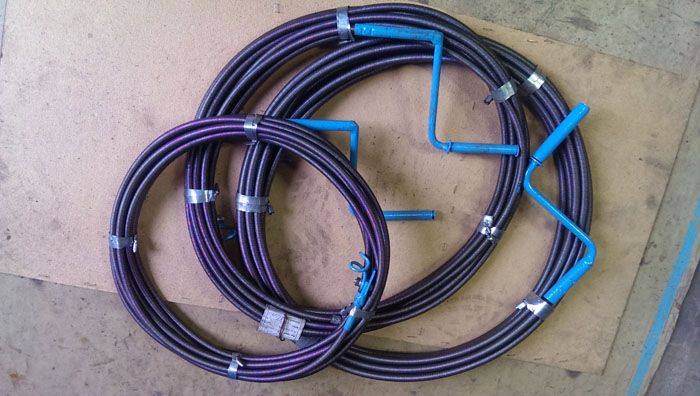
When choosing a fixture, consider the pipe diameter
Types of sewer blockages
Understanding their nature is very important for the correct selection of the cable. Plumbing plugs differ in reasons of occurrence, respectively, and their strength can also be different
 Plumbing plug in the knee
Plumbing plug in the knee
Operational blockage
An inevitable problem for any sewage system. It occurs due to the fact that particles of food, fat, fabric, hair, wool, sand and other very small debris are washed into the kitchen sink, which accumulates on the walls of pipes for months and years, forming dense plugs. To eliminate them, a thin cord will be enough, since such a blockage is called the simplest.
Mechanical plugs
They appear due to solid large objects or plastic bags dropped into the toilet bowl, which become a wedge in the pipe, collecting the rest of the debris.To remove such a blockage, it is necessary to use a powerful thick cable for cleaning the sewer, which will forcefully damage and advance the stuck object. If the object is very durable, then the device will not be able to damage it, and you will have to:
- calculate the location of the plug by the length of the cable;
- cut the pipe;
- physically remove it.
Technological blockage
It occurs as a natural process of sedimentation on pipes of solid fractions.
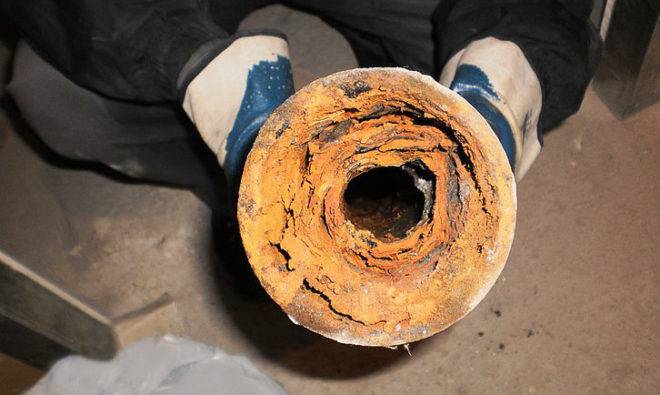 Technological blockage of the sewage system
Technological blockage of the sewage system
They have a very strong structure and are located almost along the entire length of the sewer pipe. Here, even a powerful cable is unlikely to help, unless it temporarily punches a hole for the drainage of wastewater. This requires a complete replacement of pipes.


